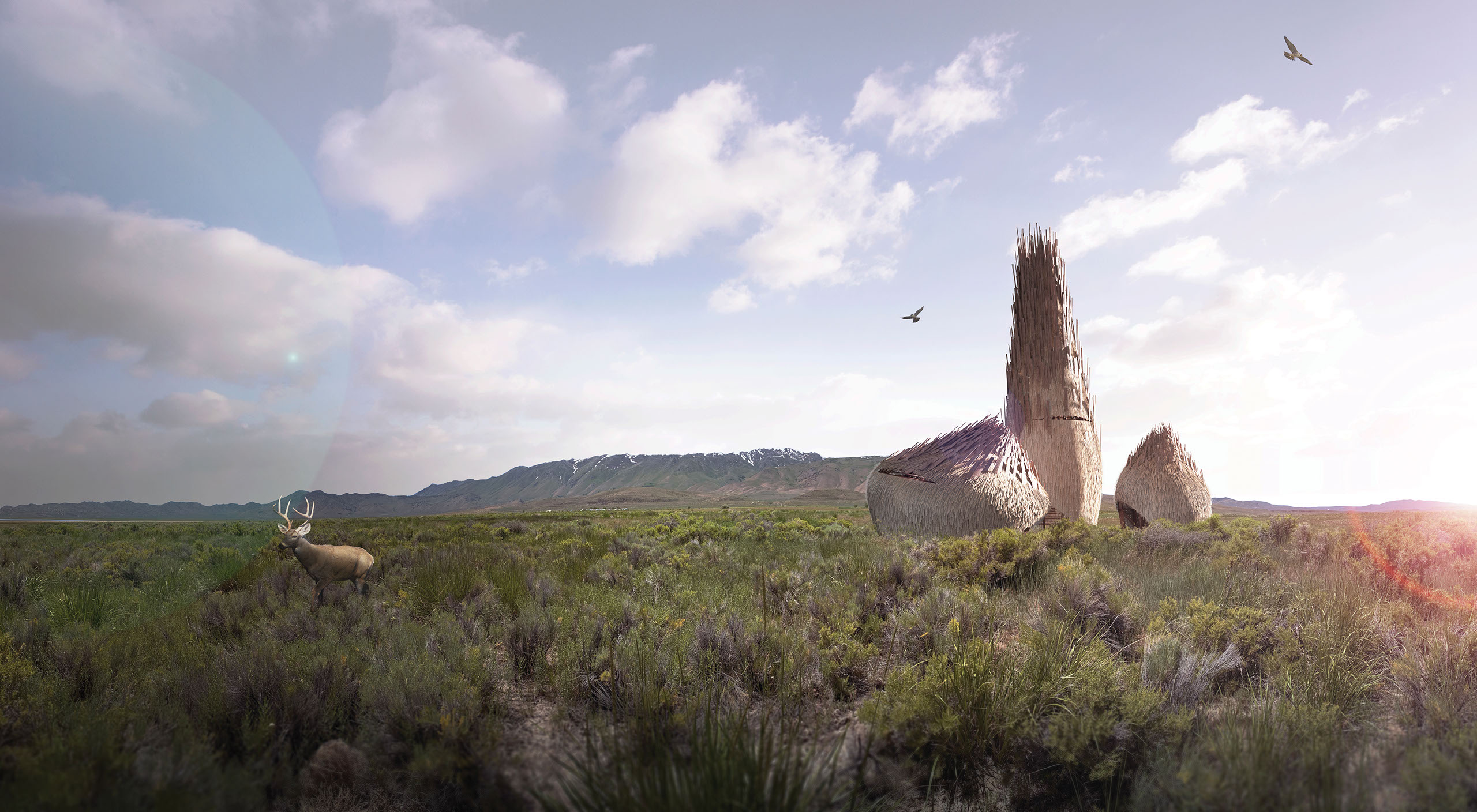


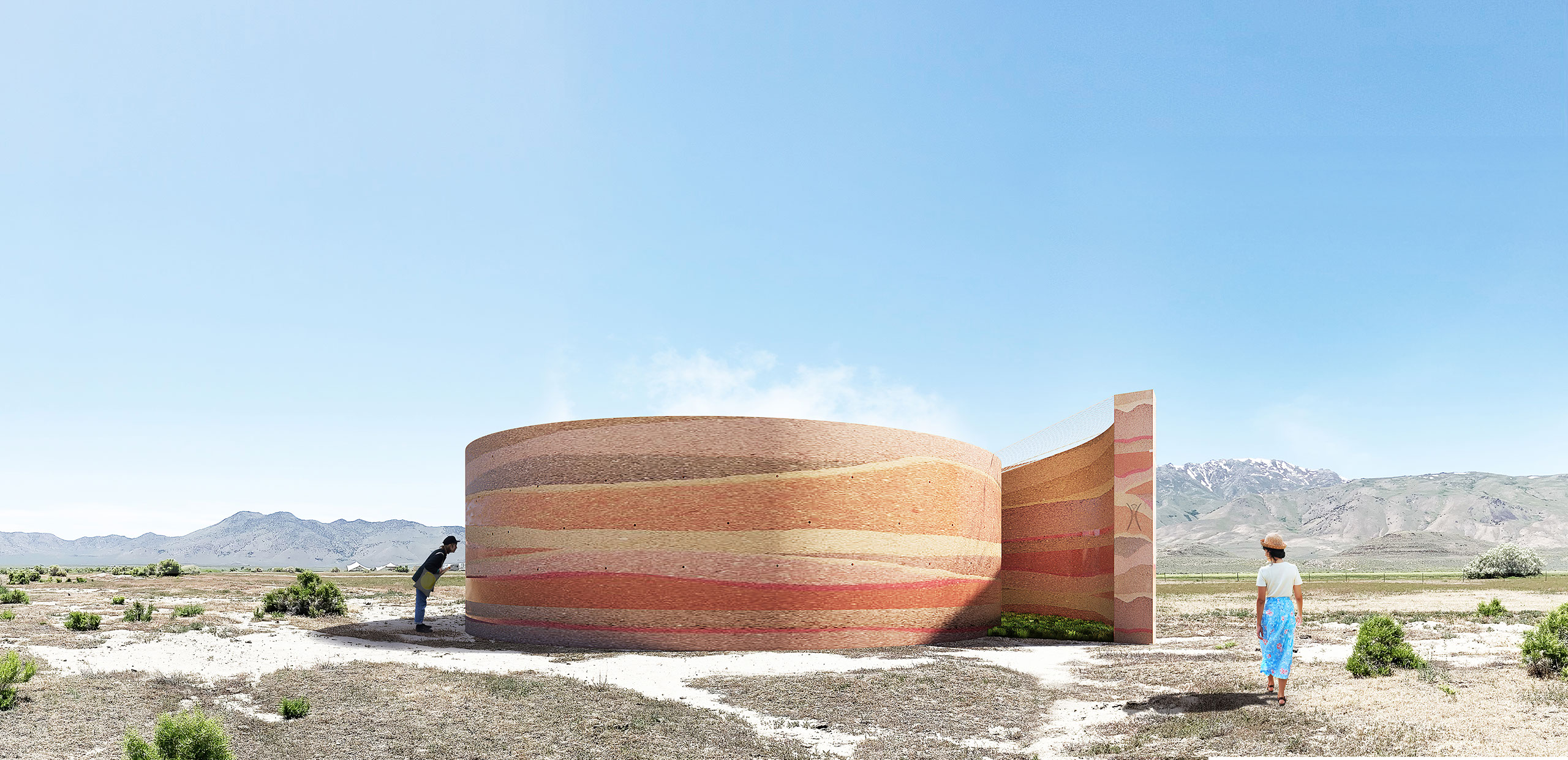
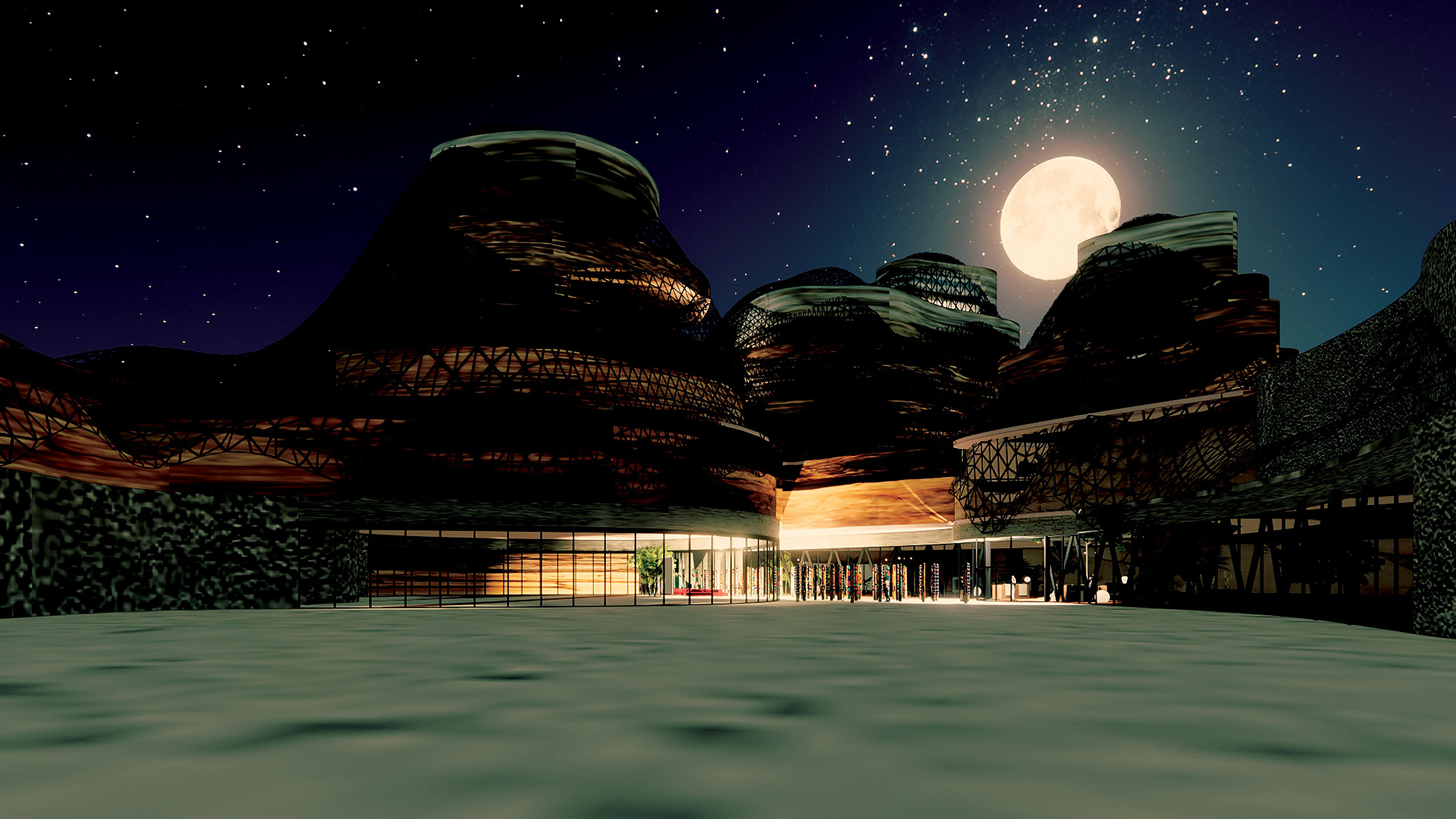
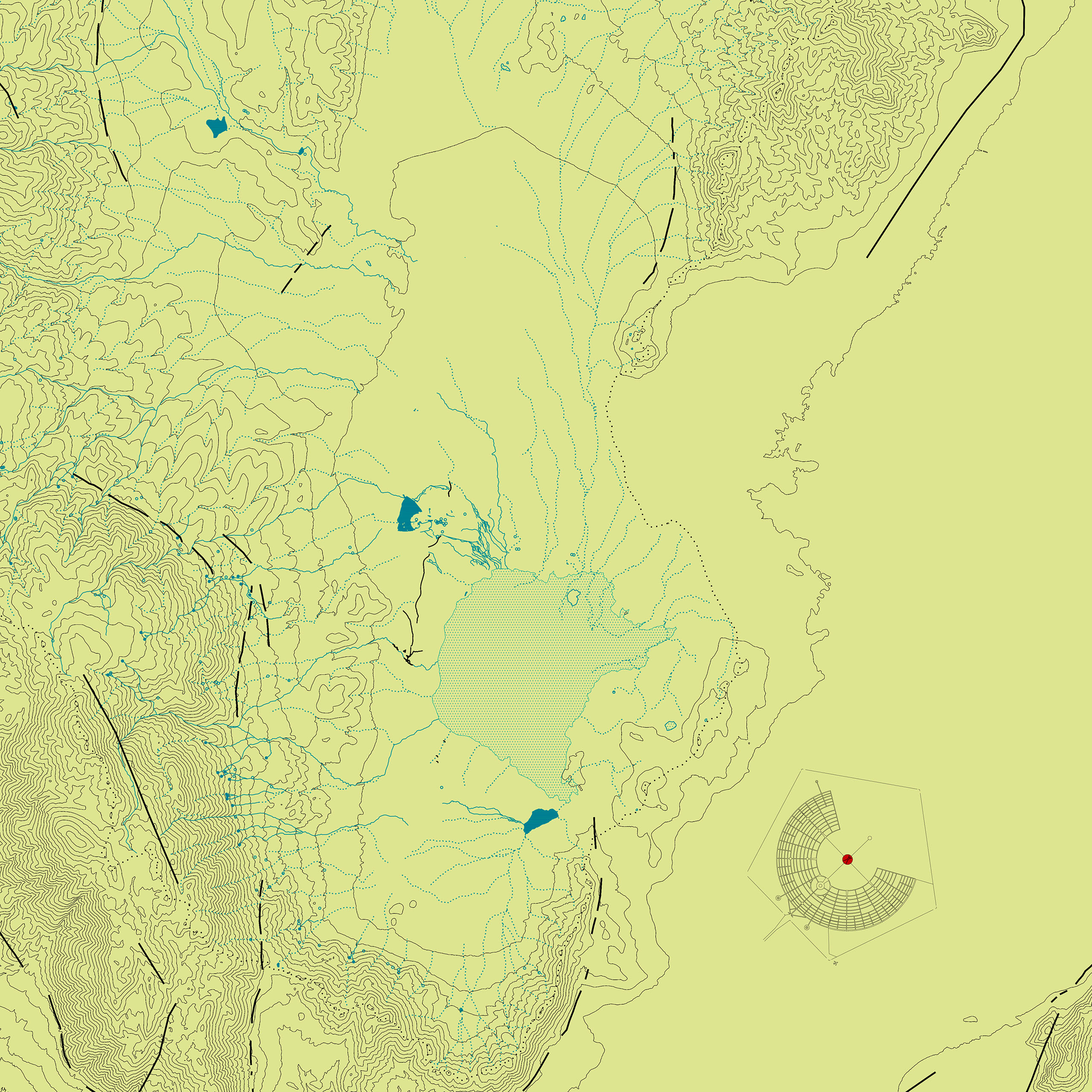
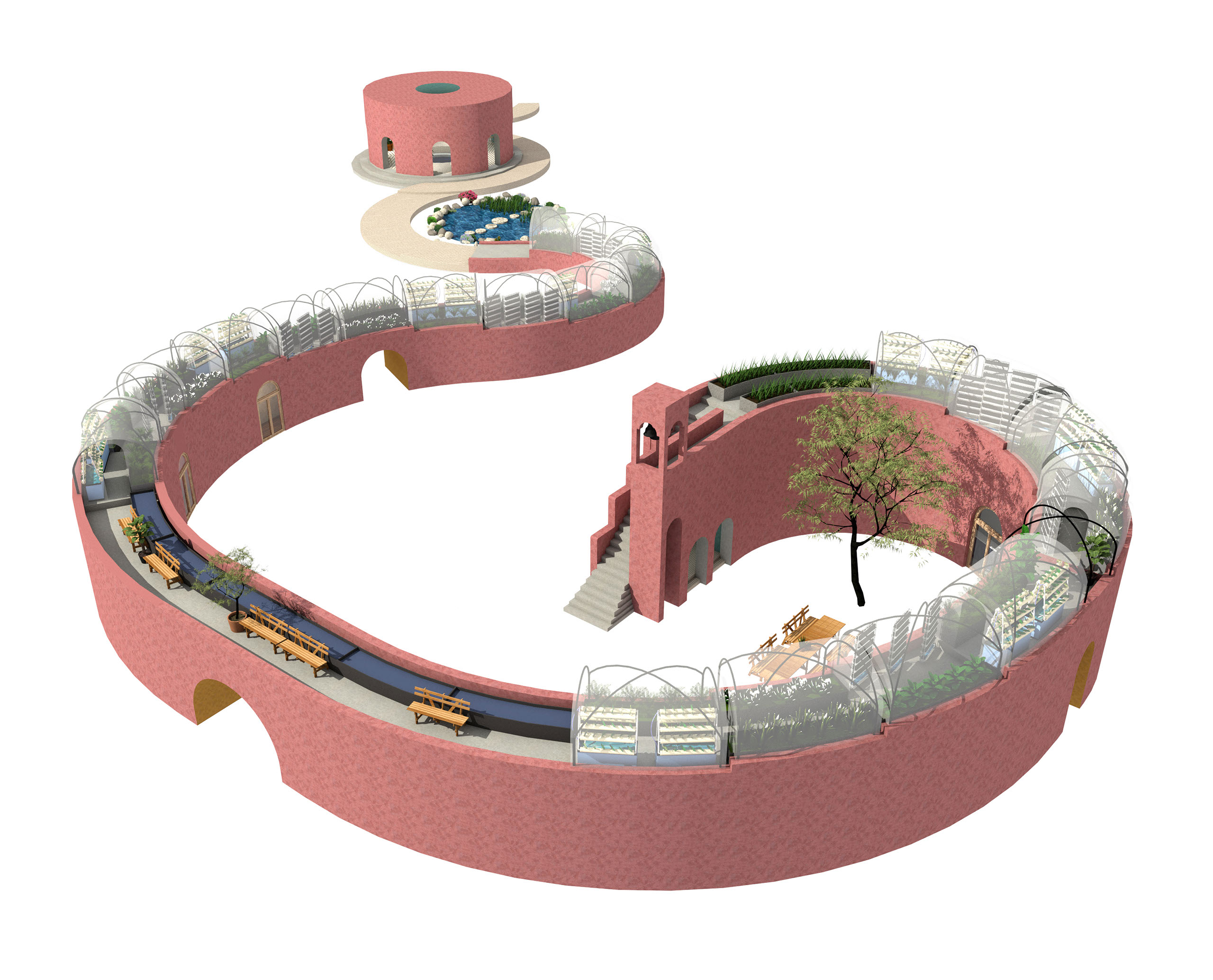
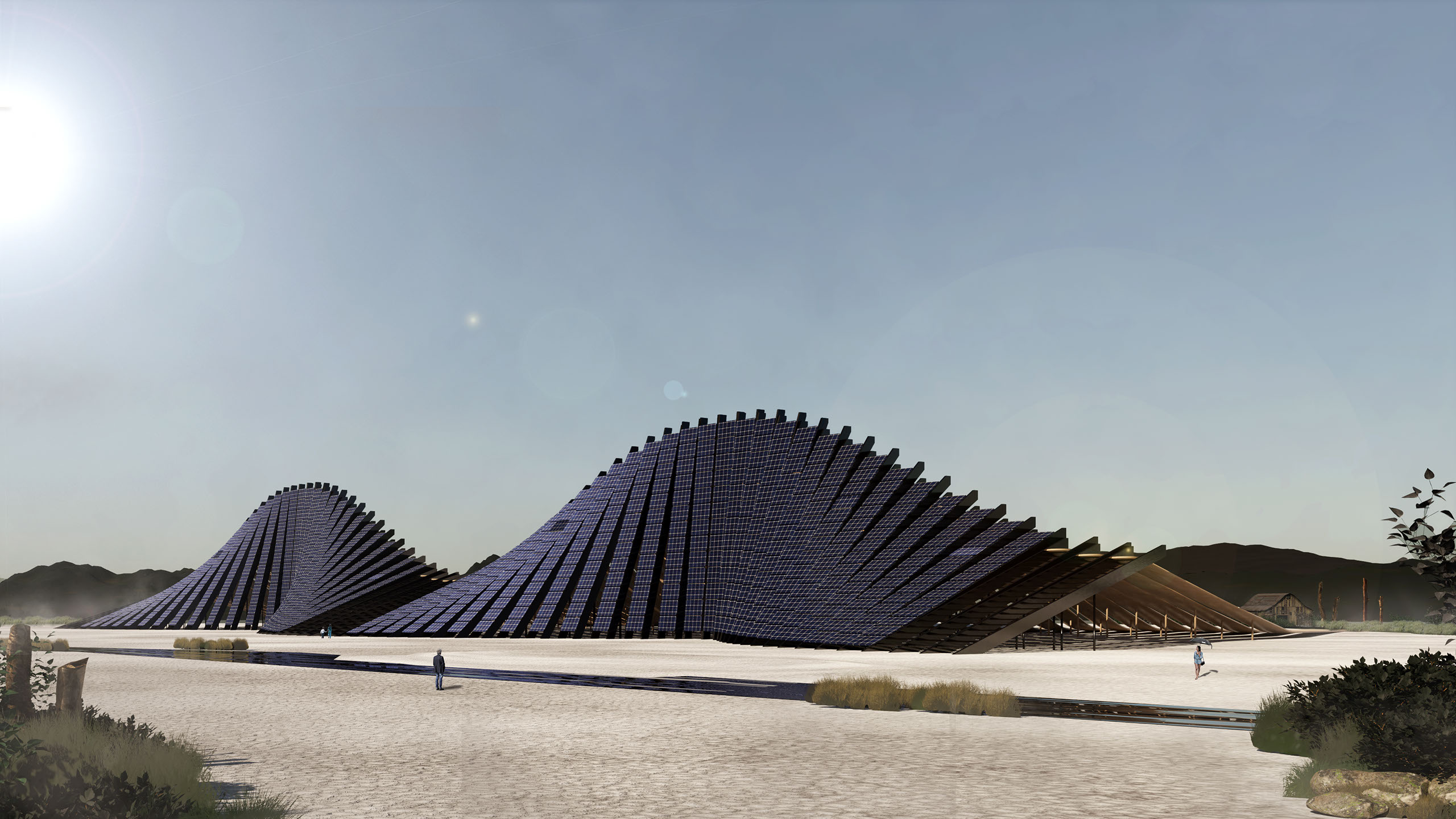
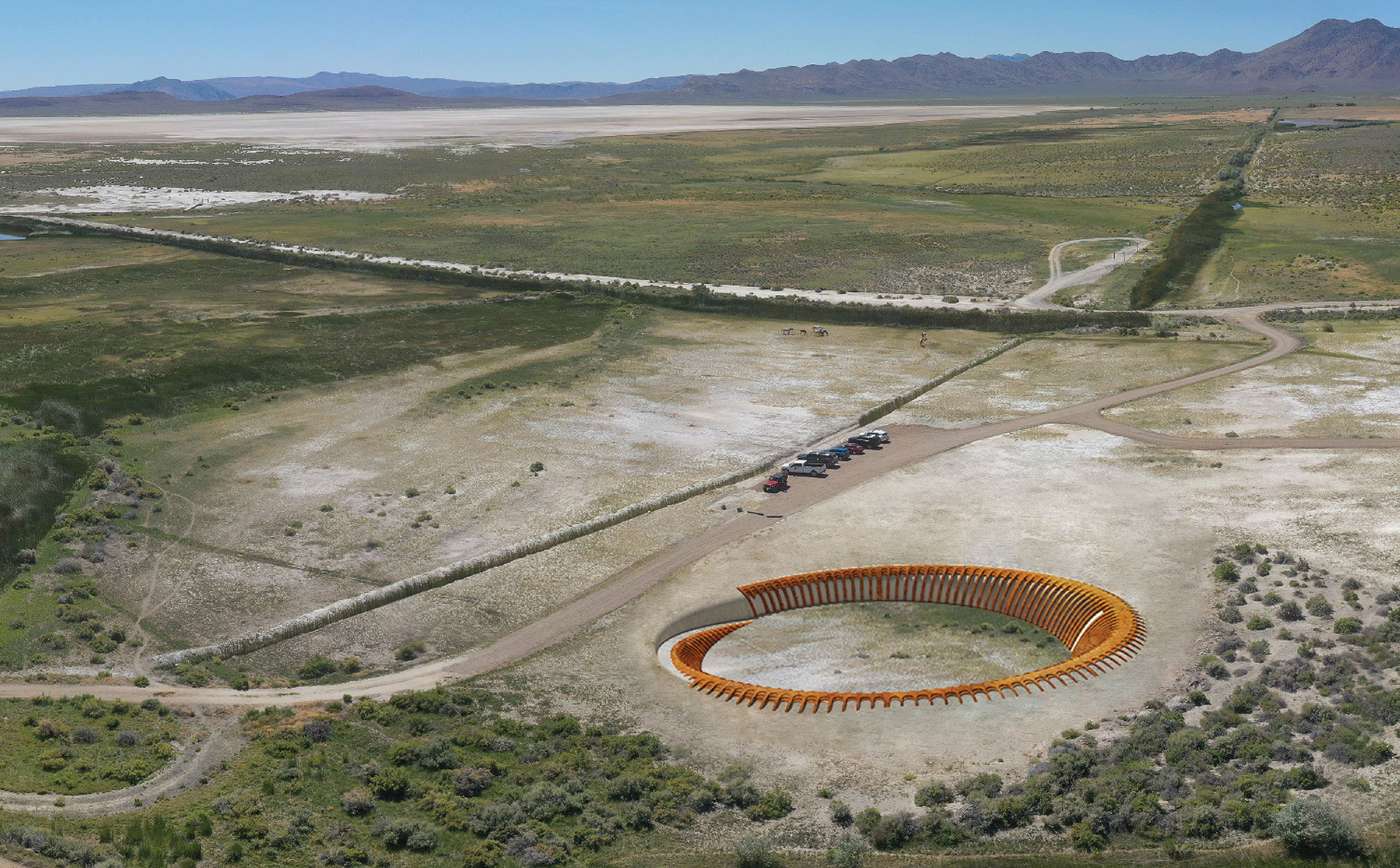
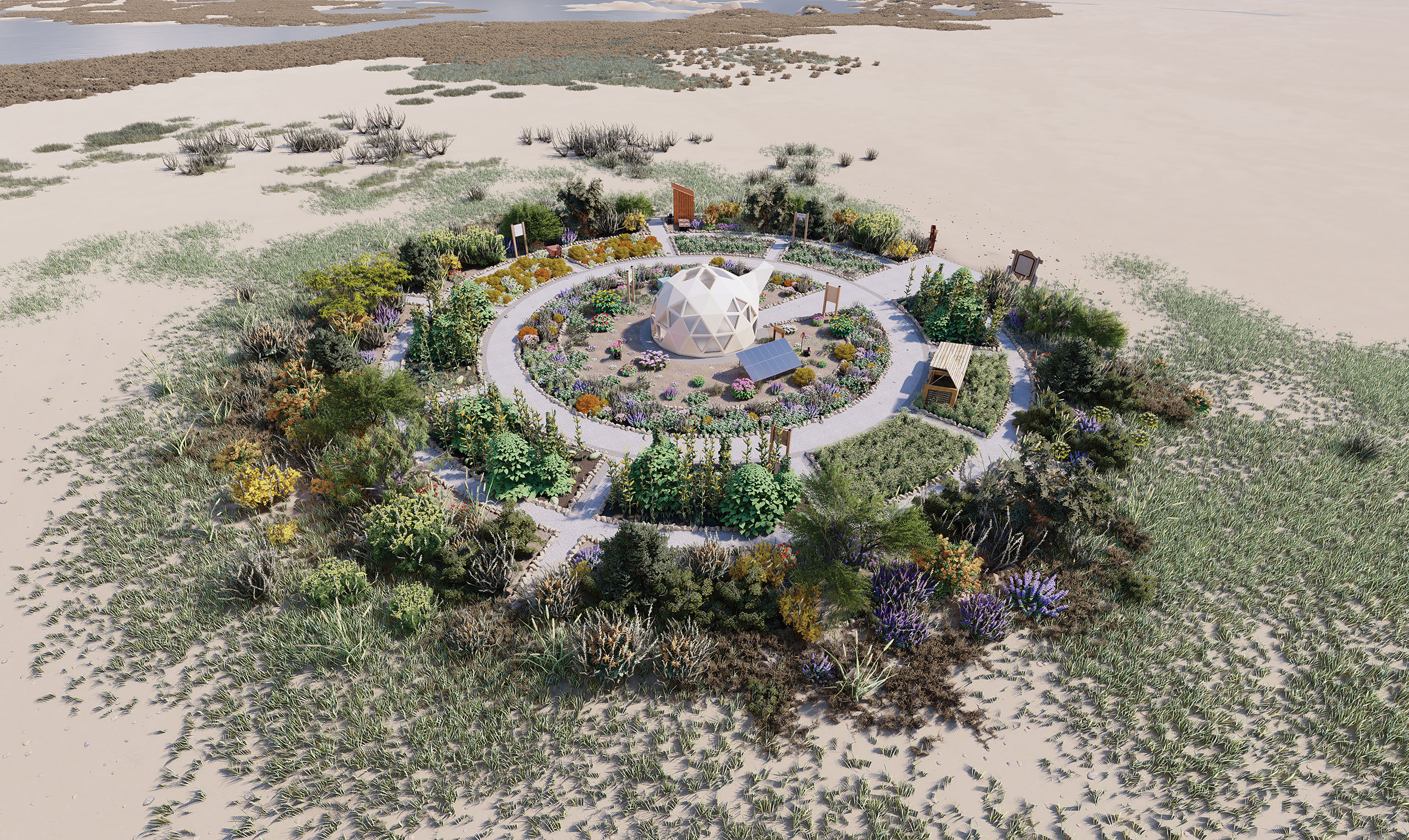
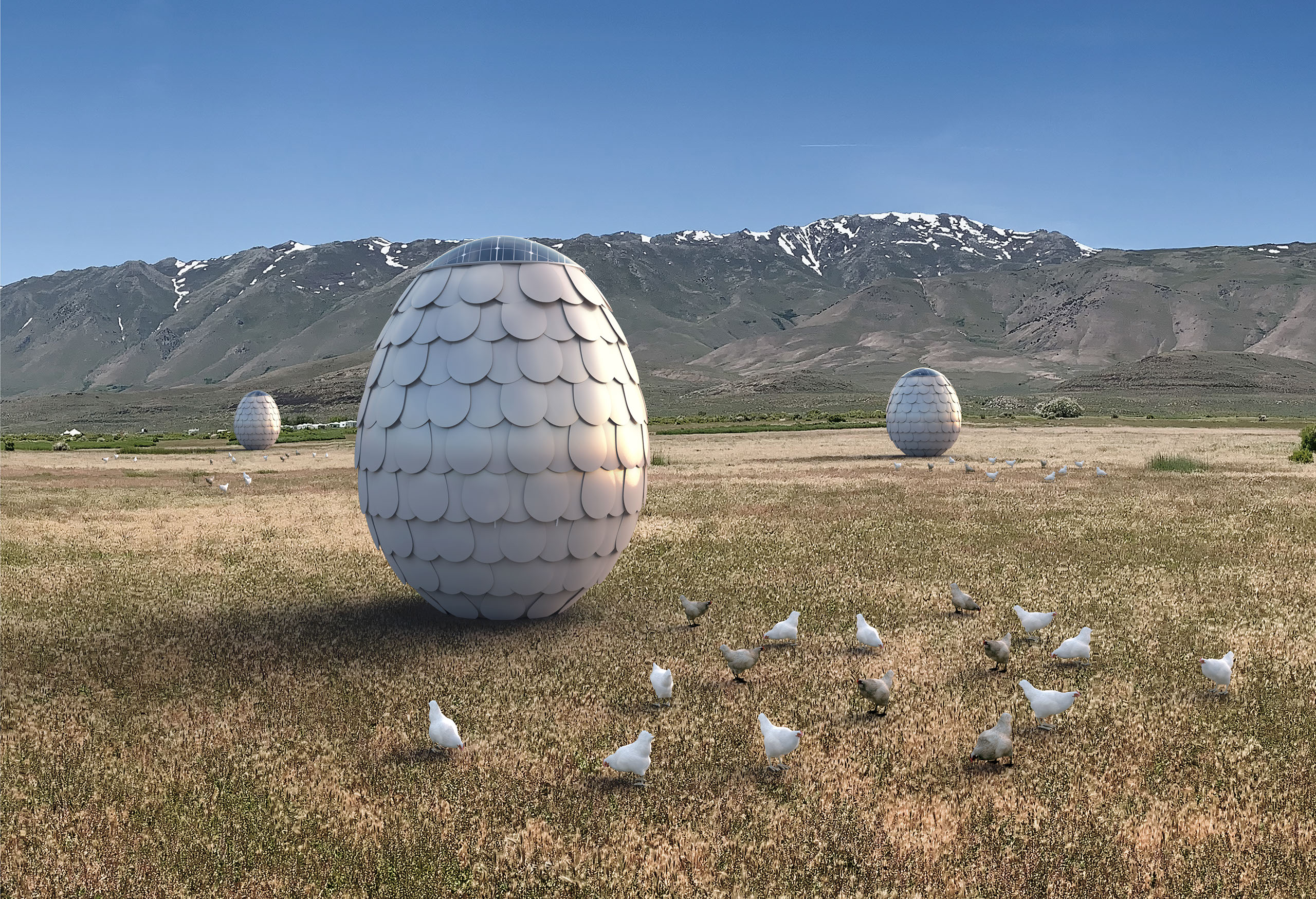
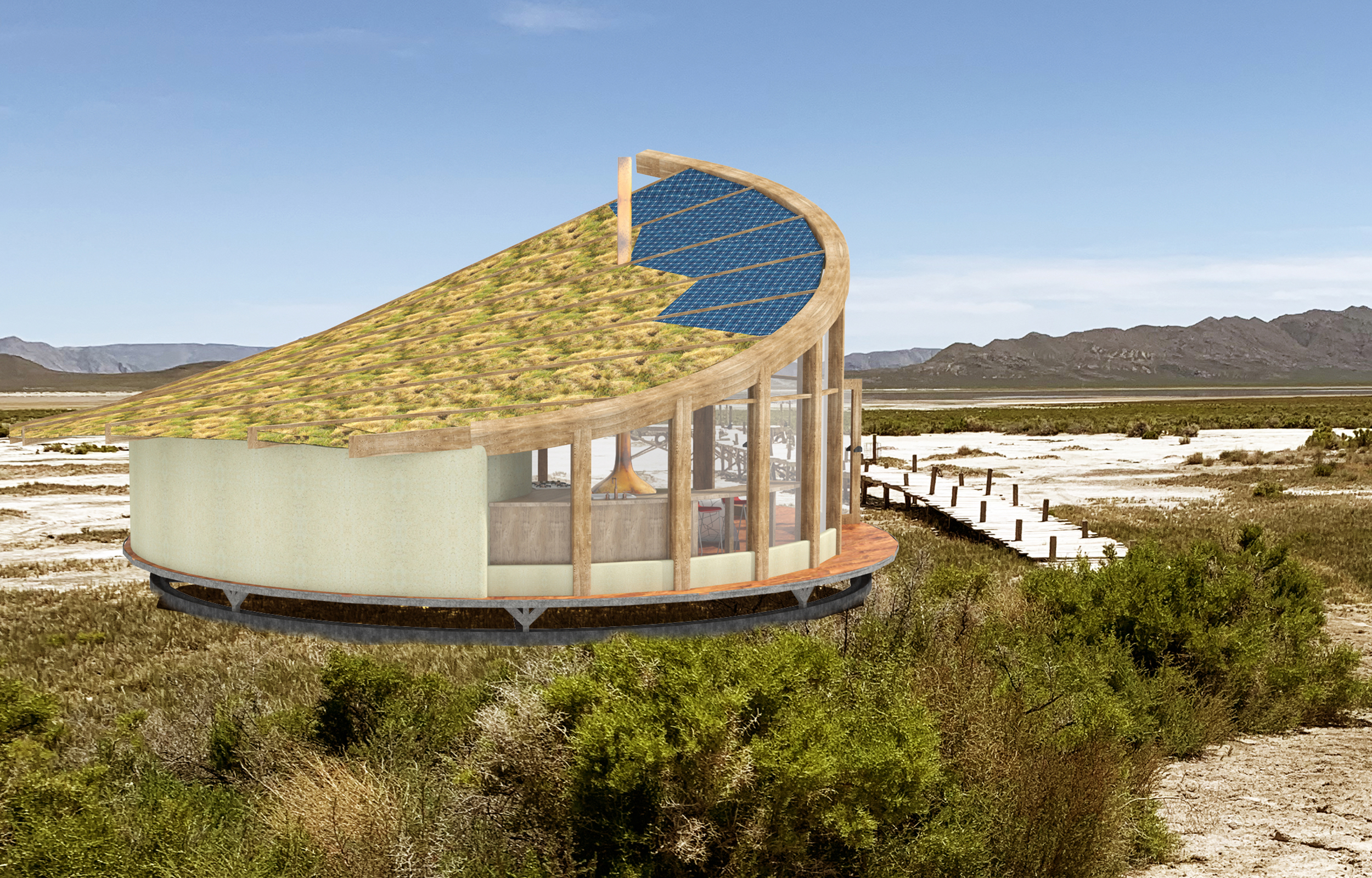
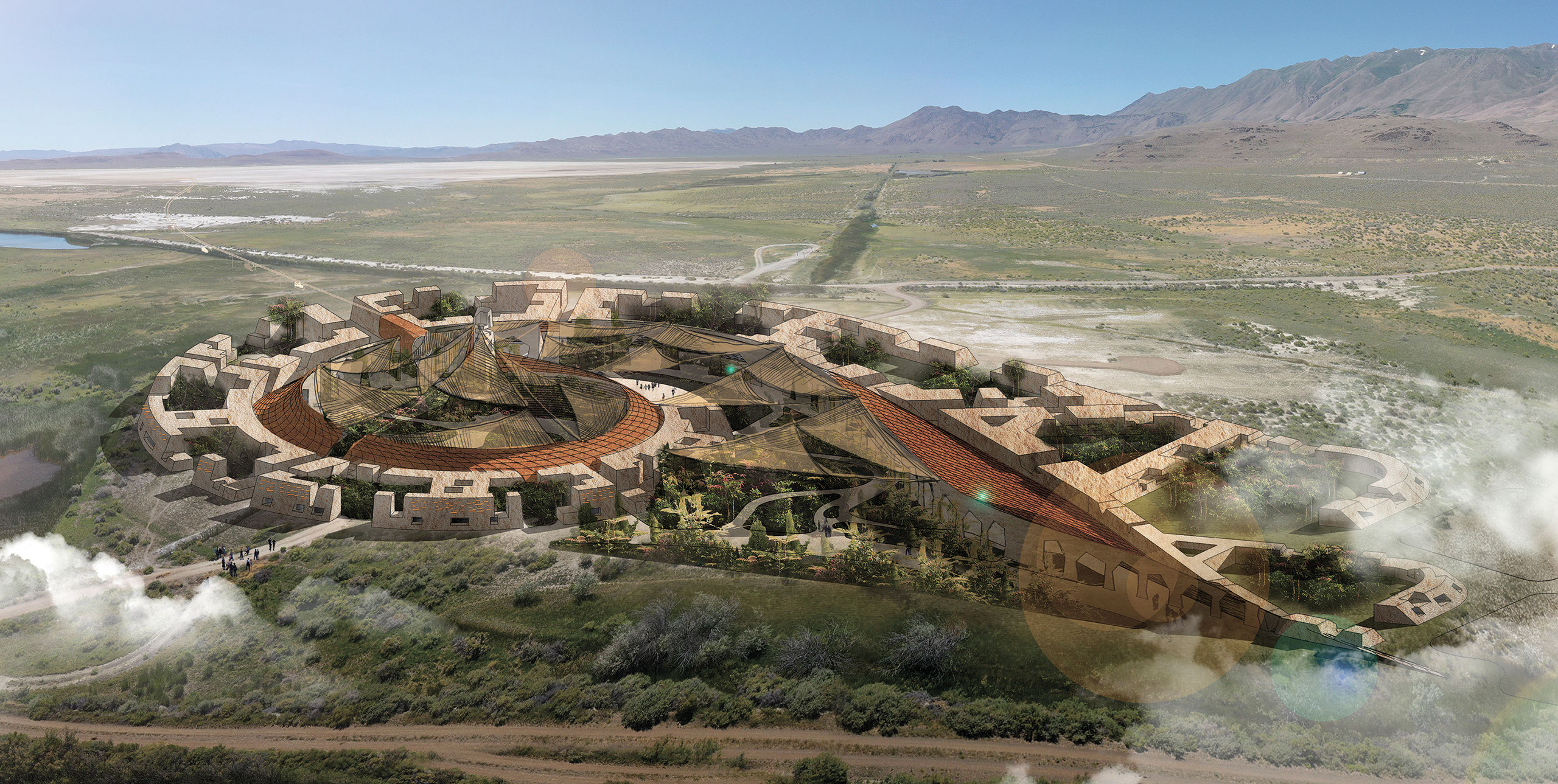
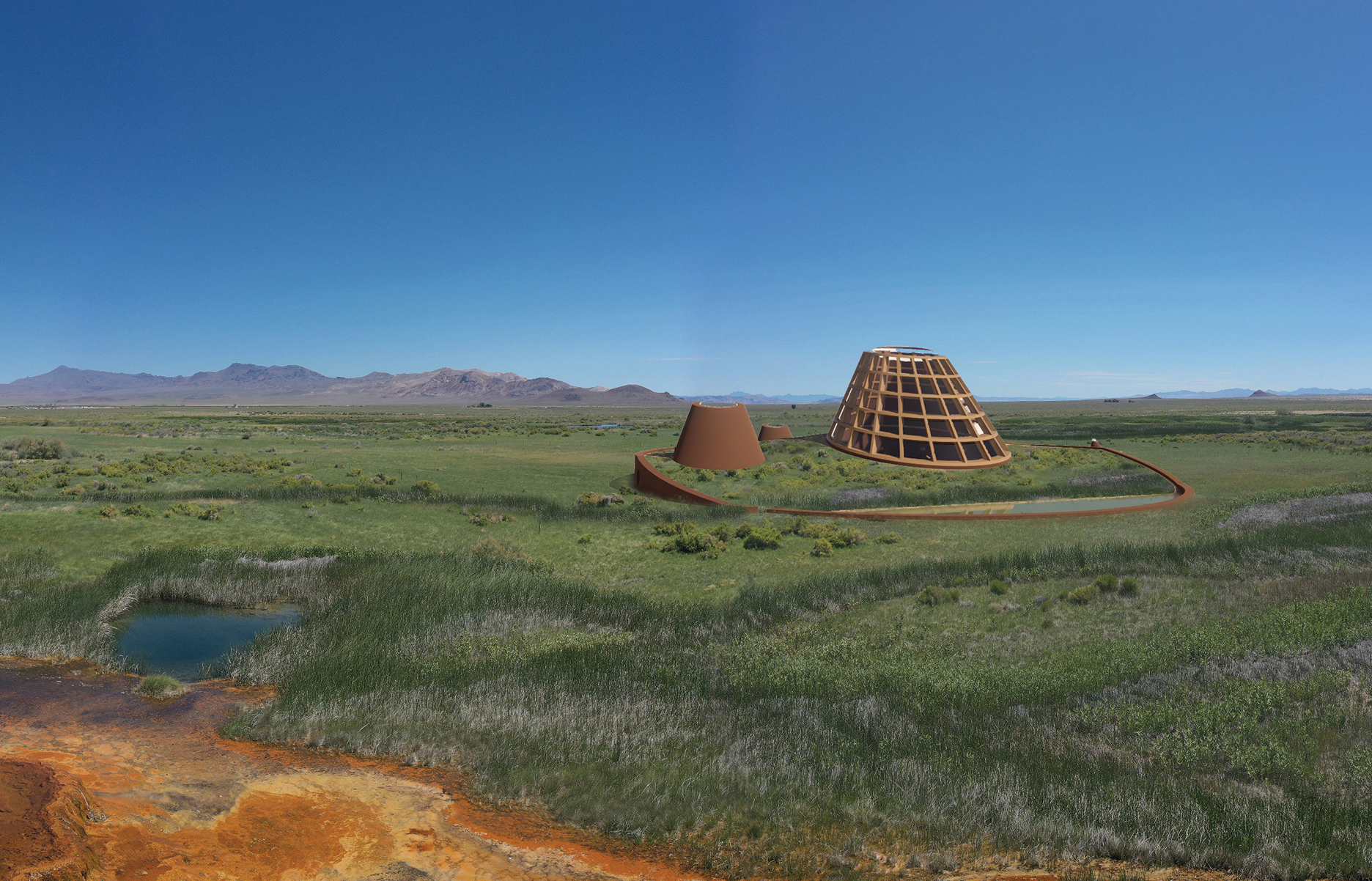


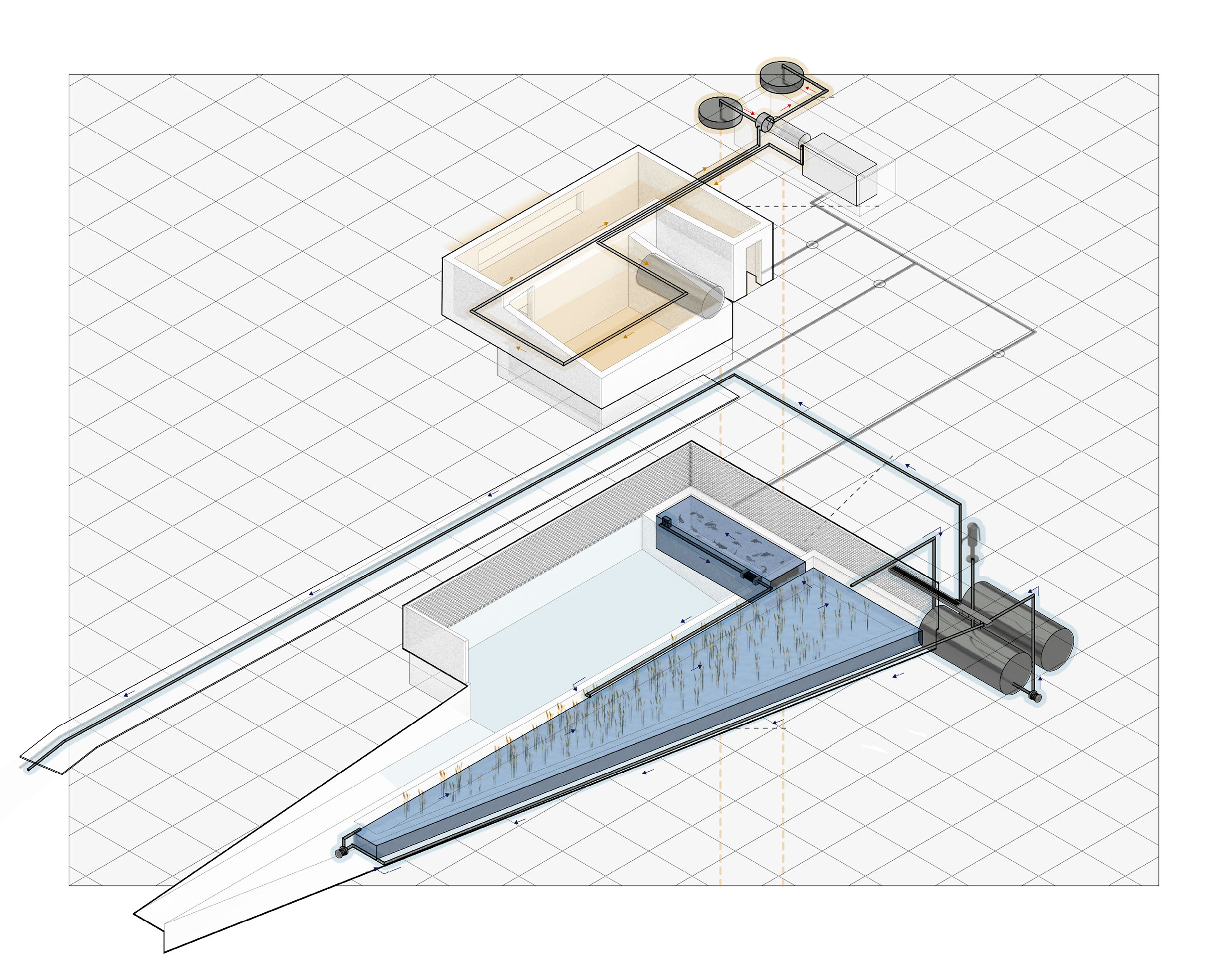


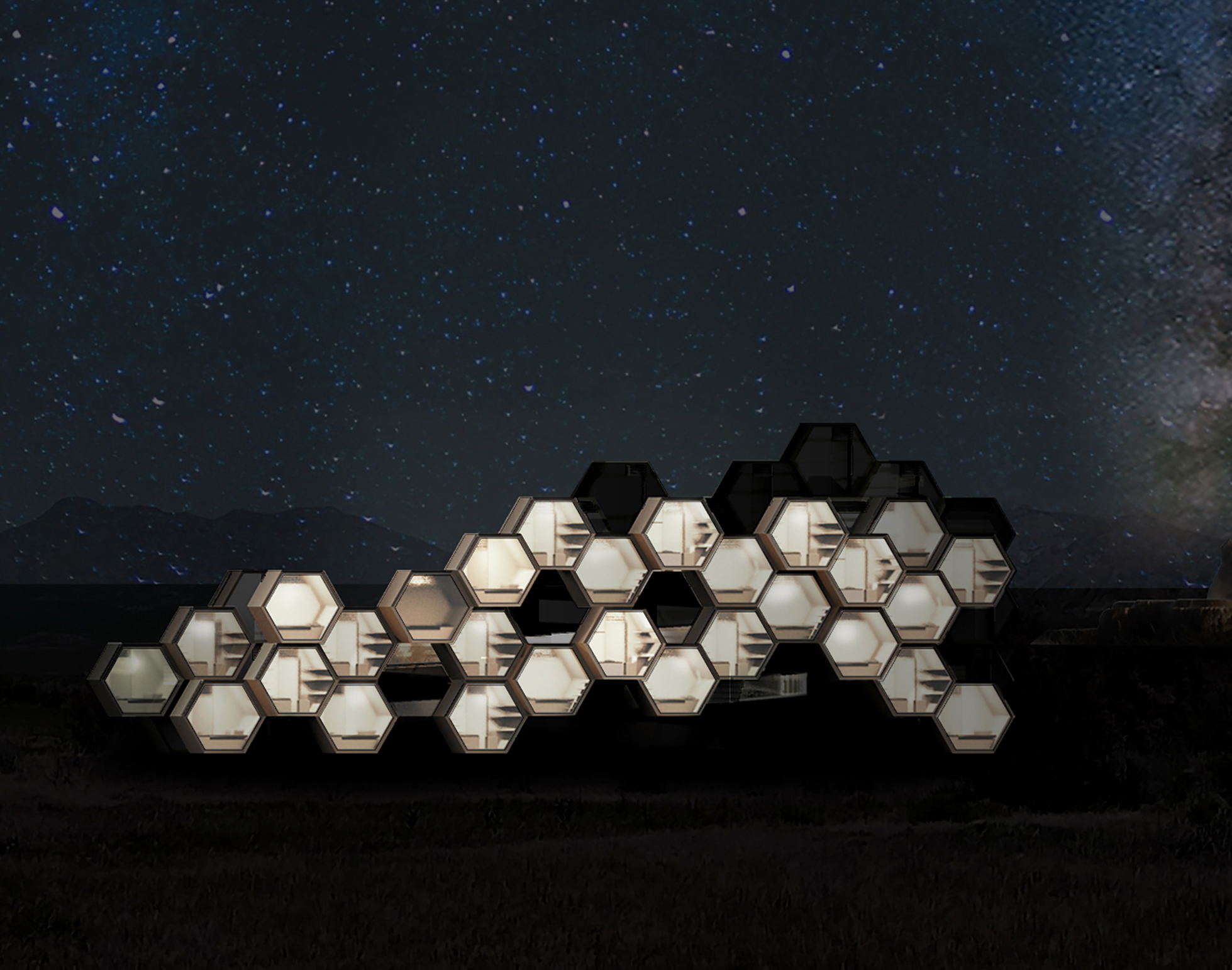
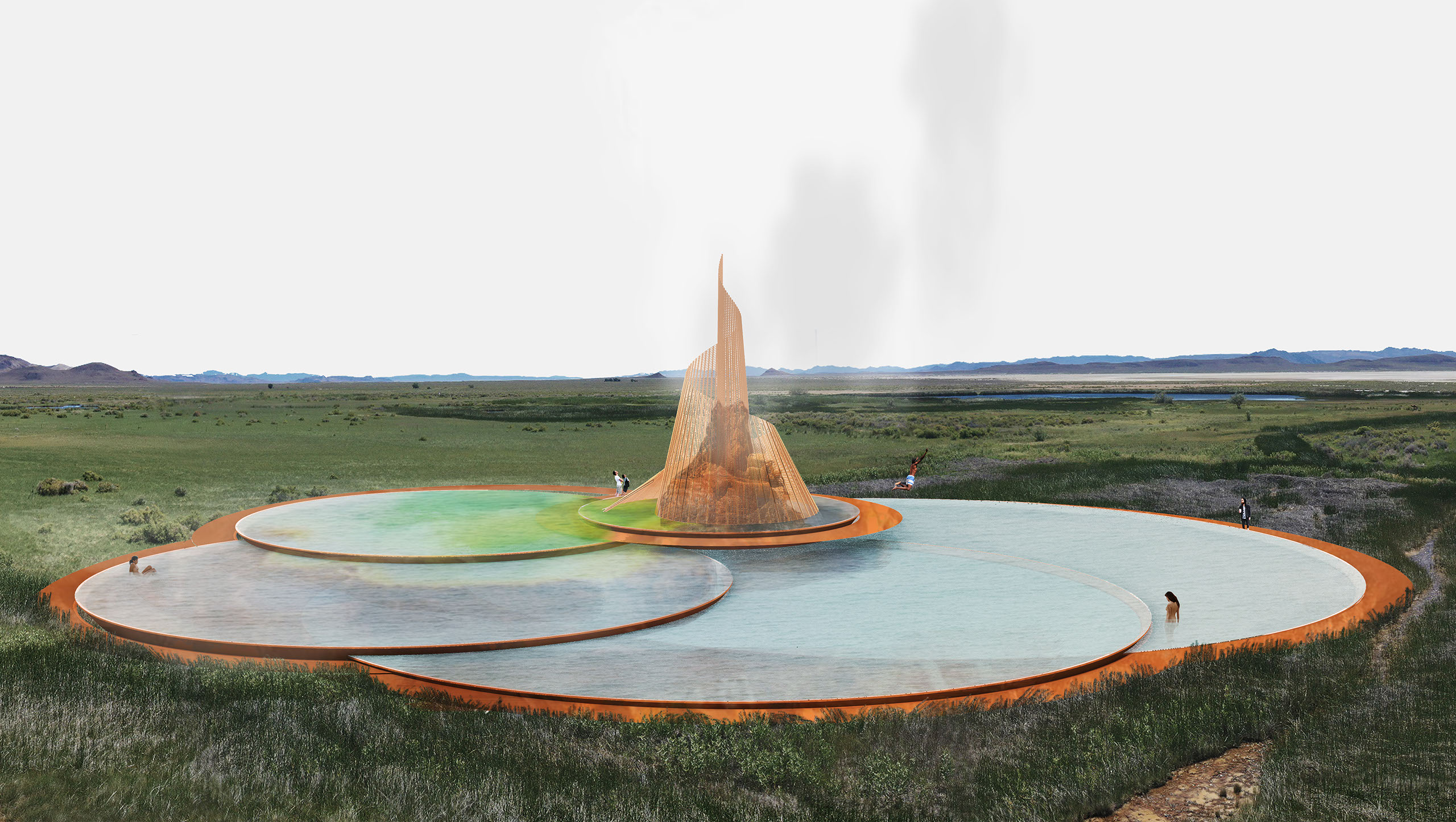



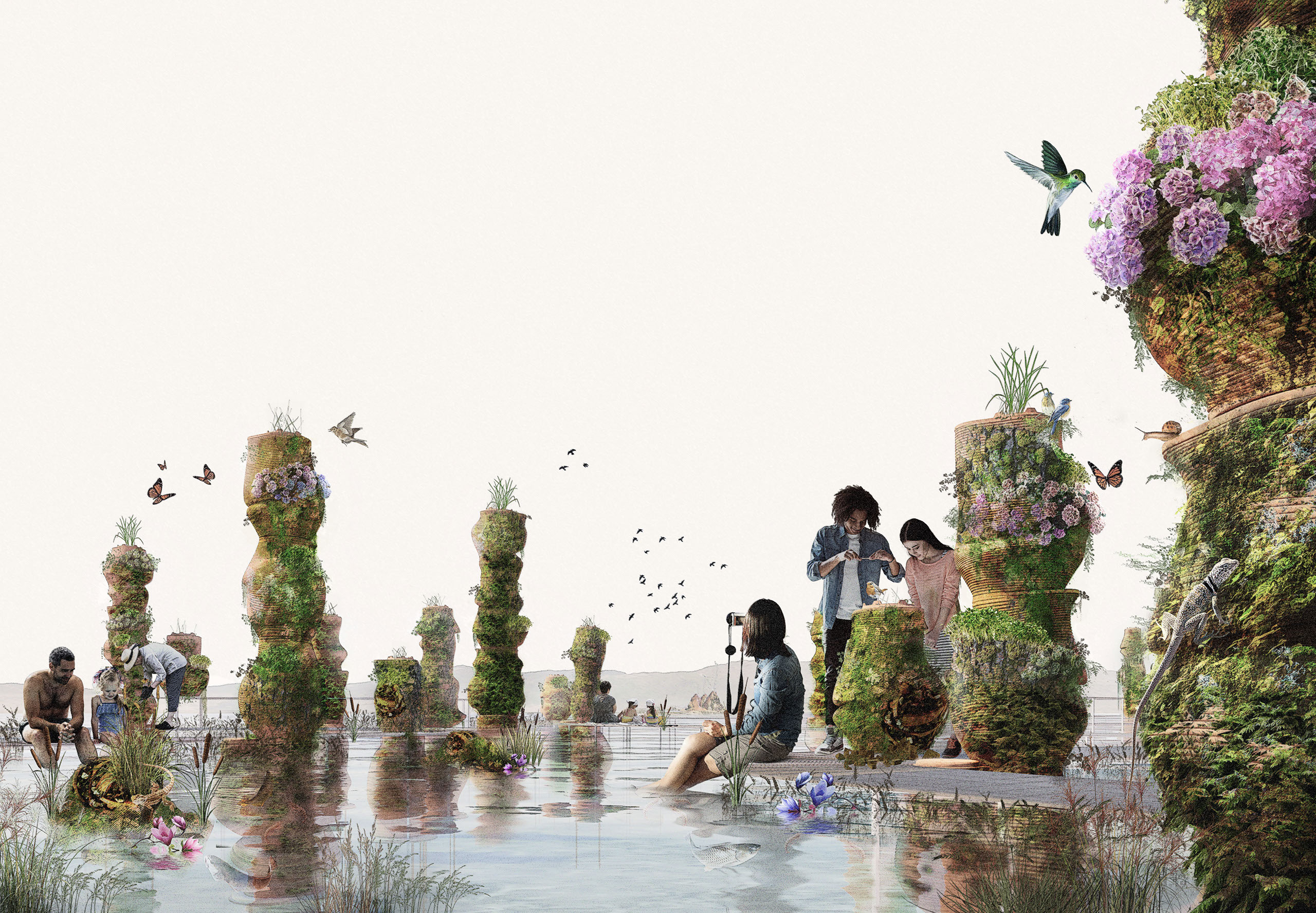
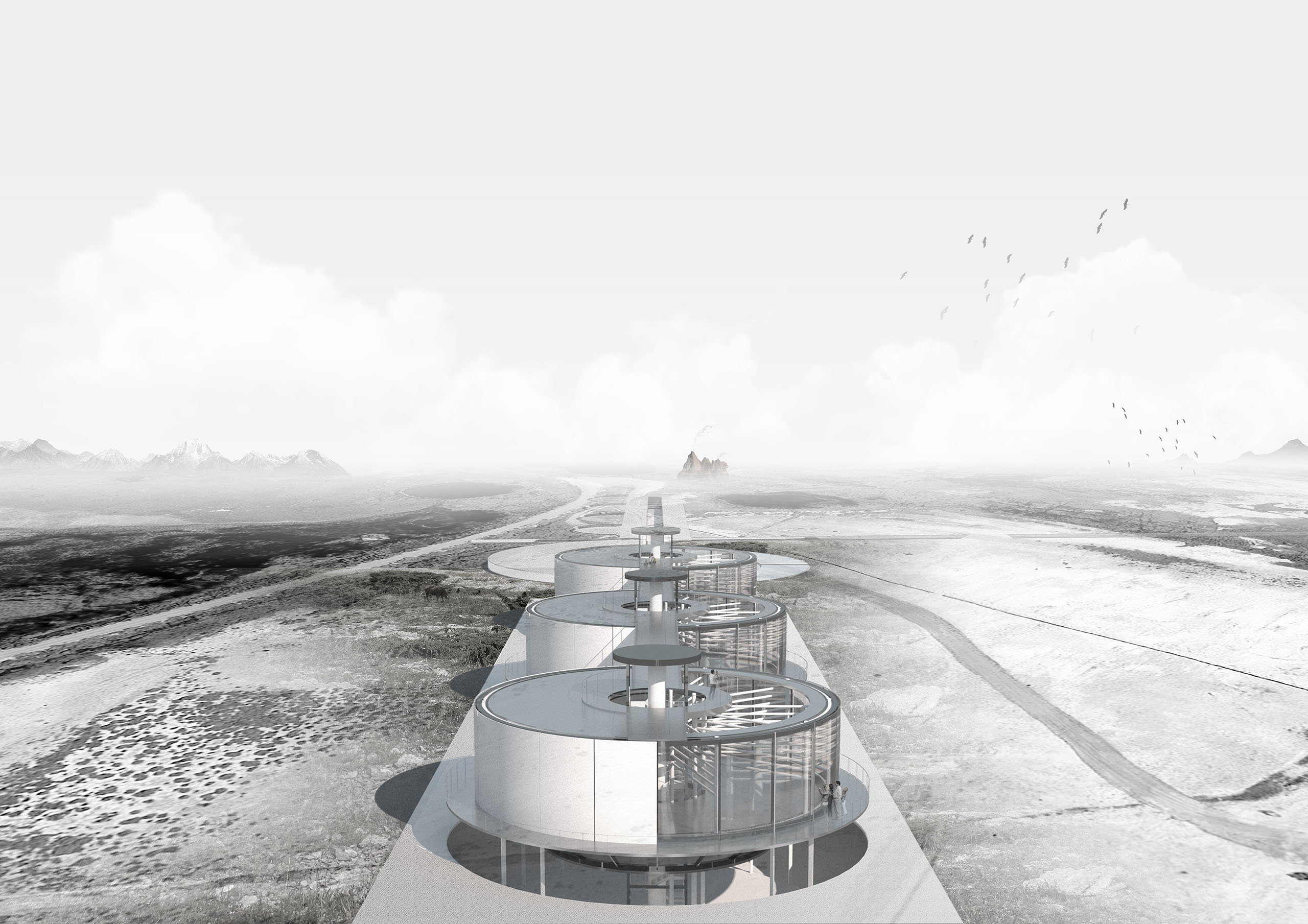

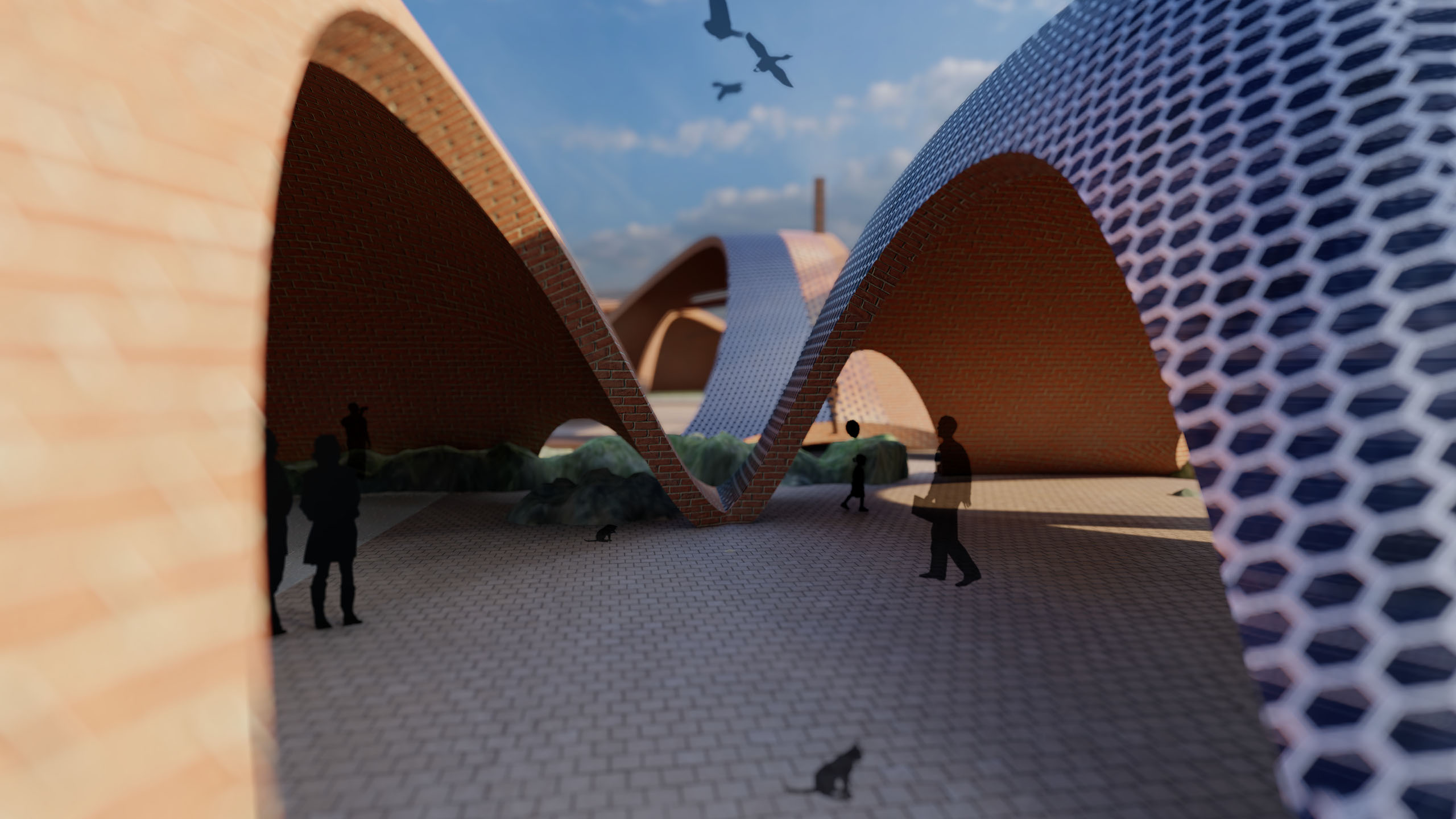
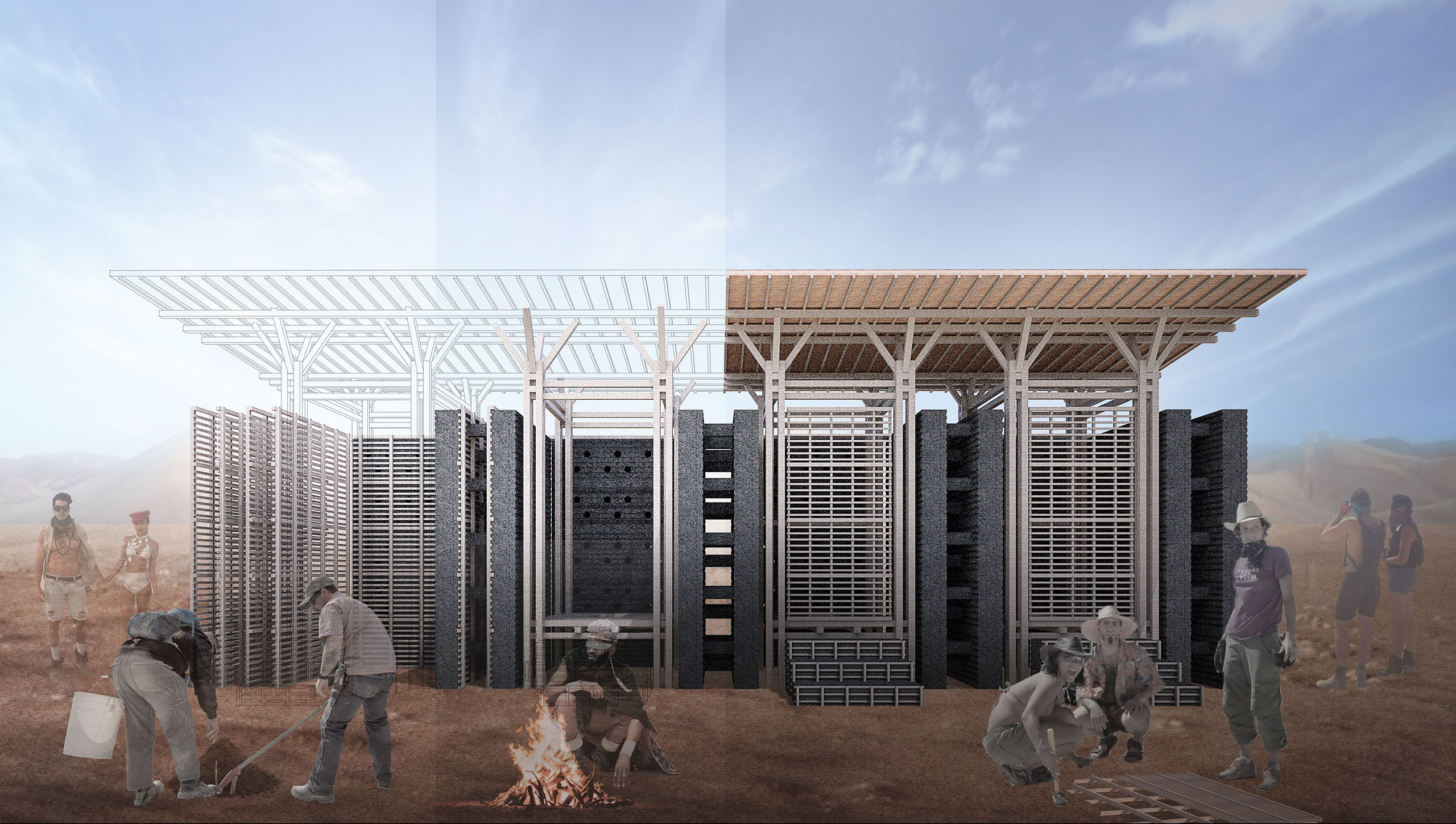
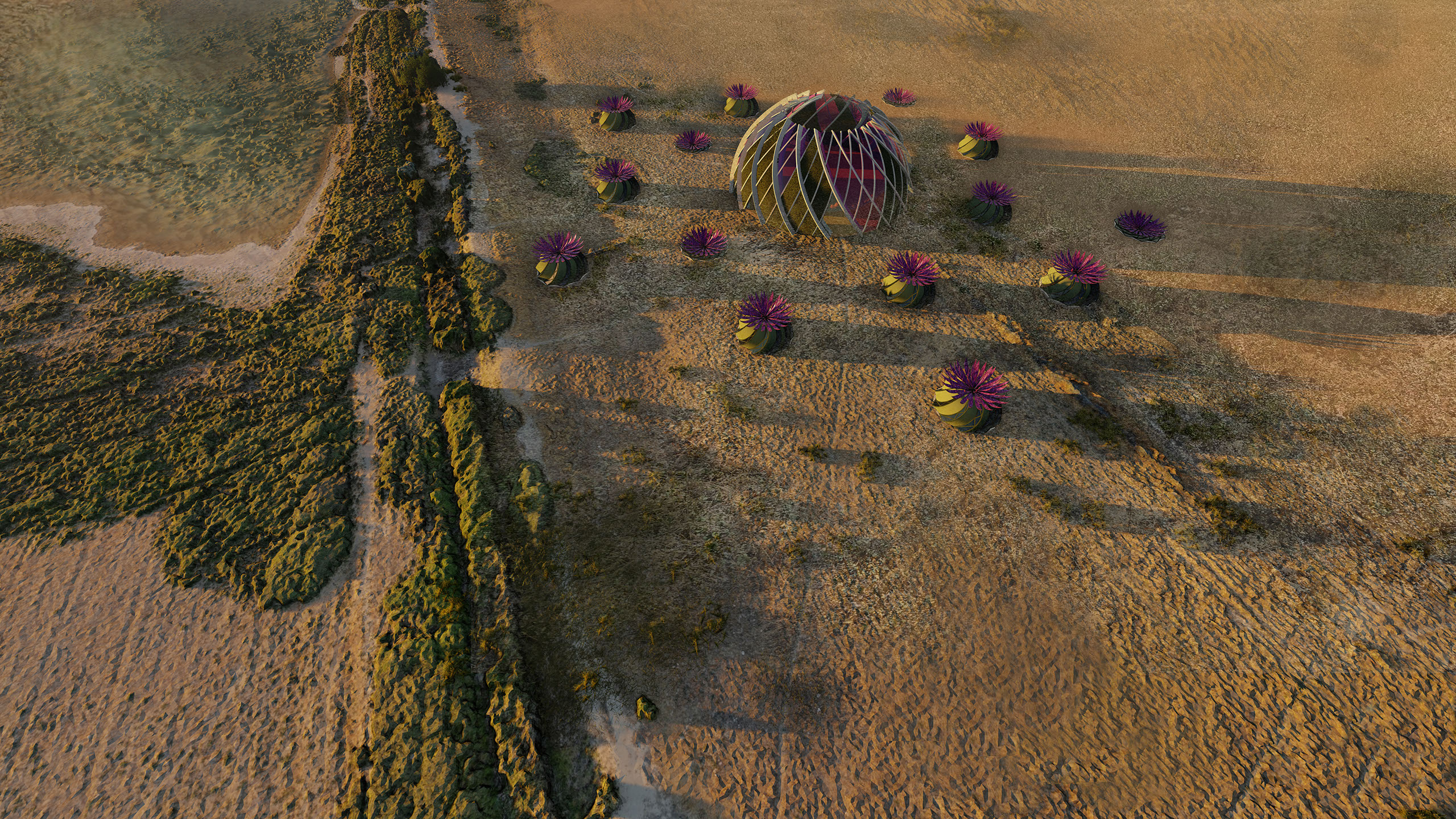

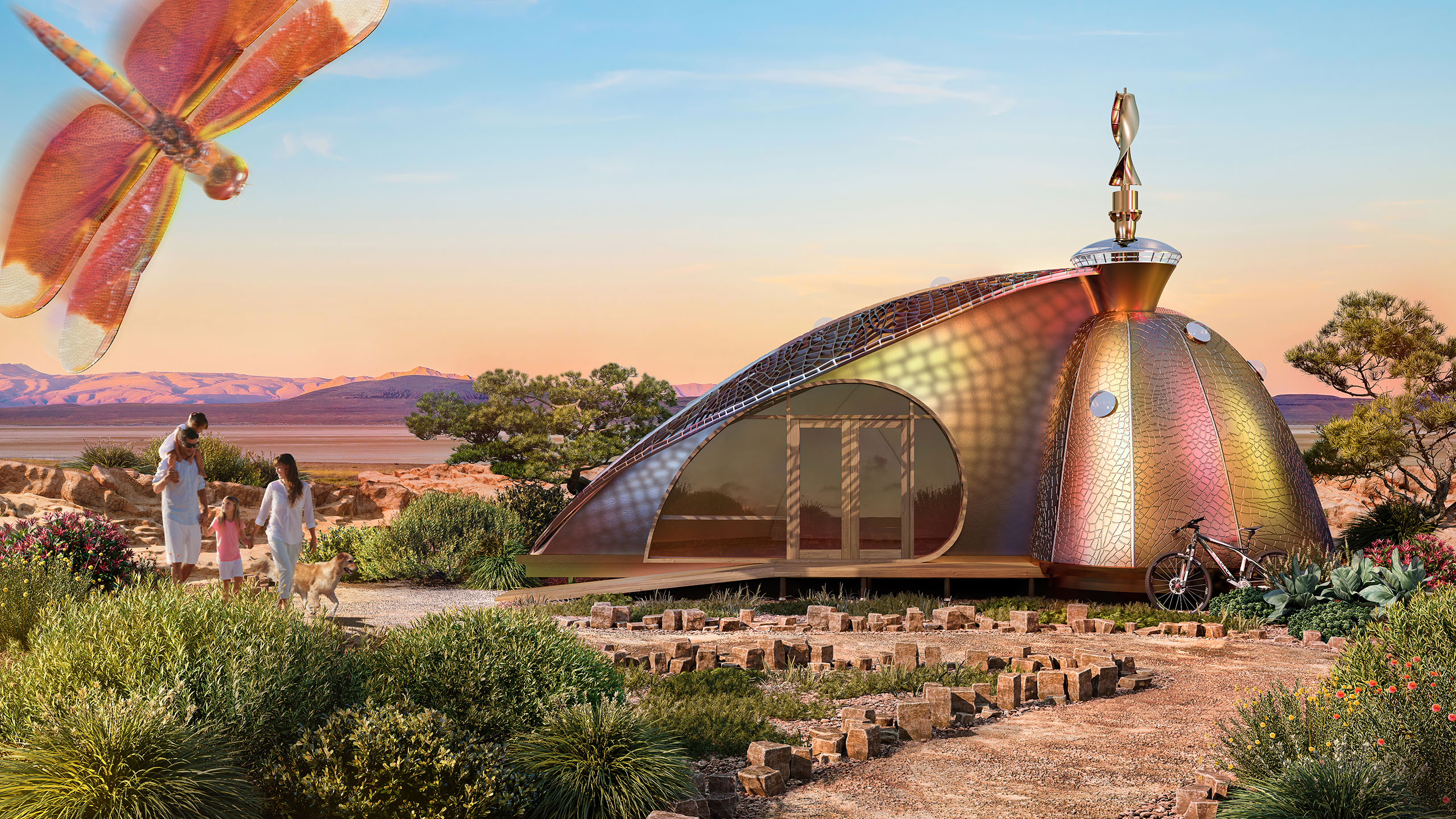
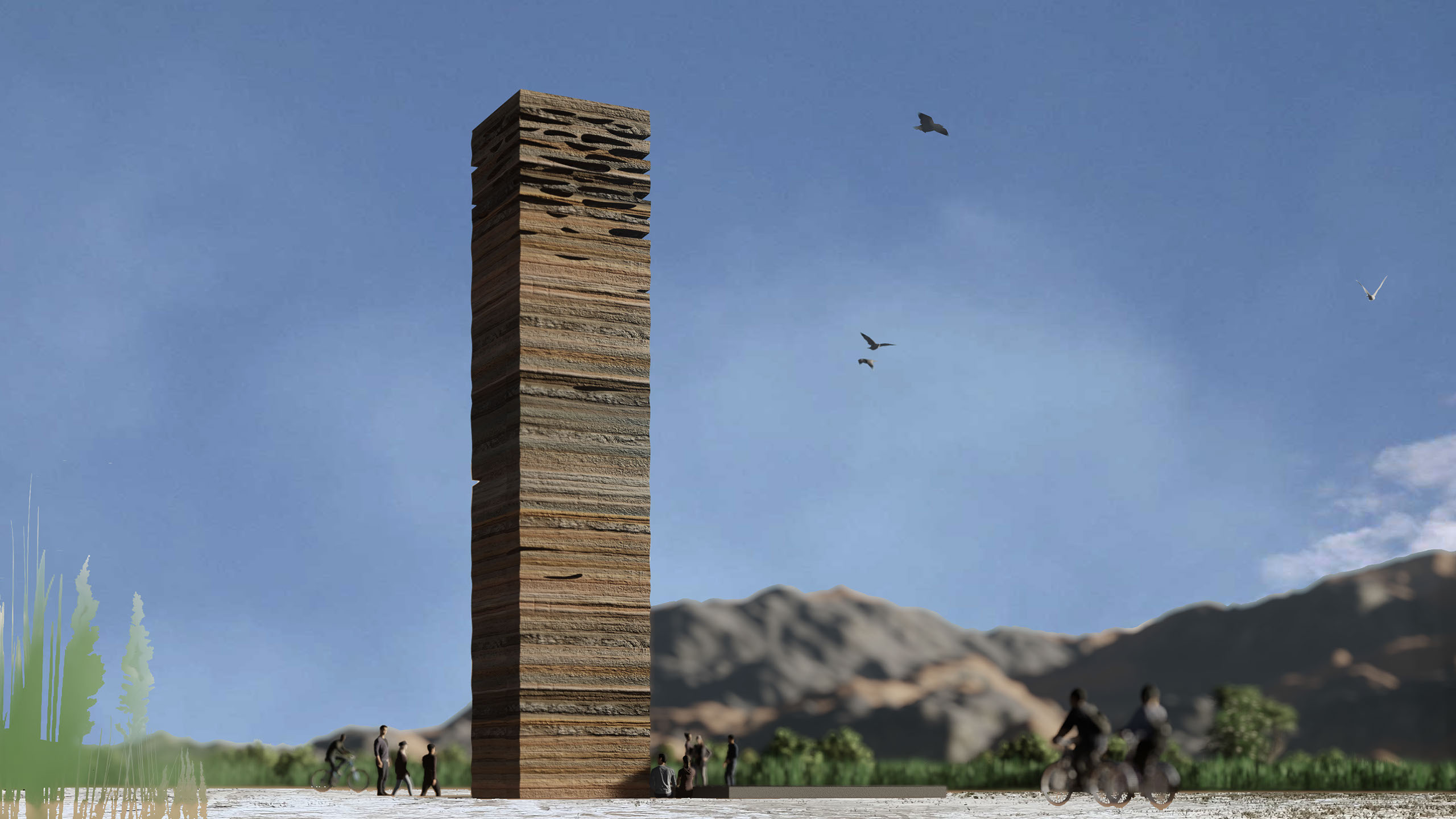
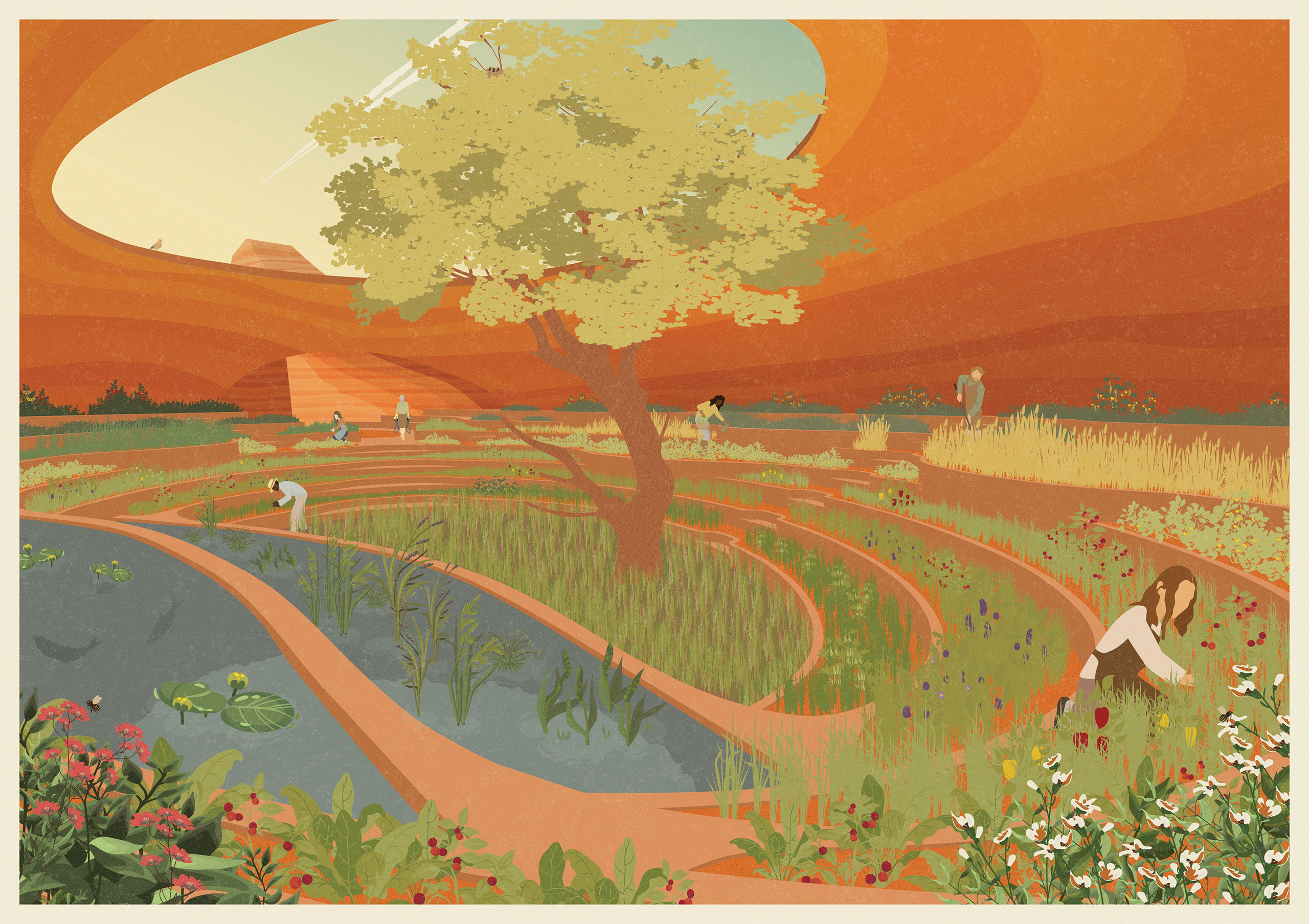
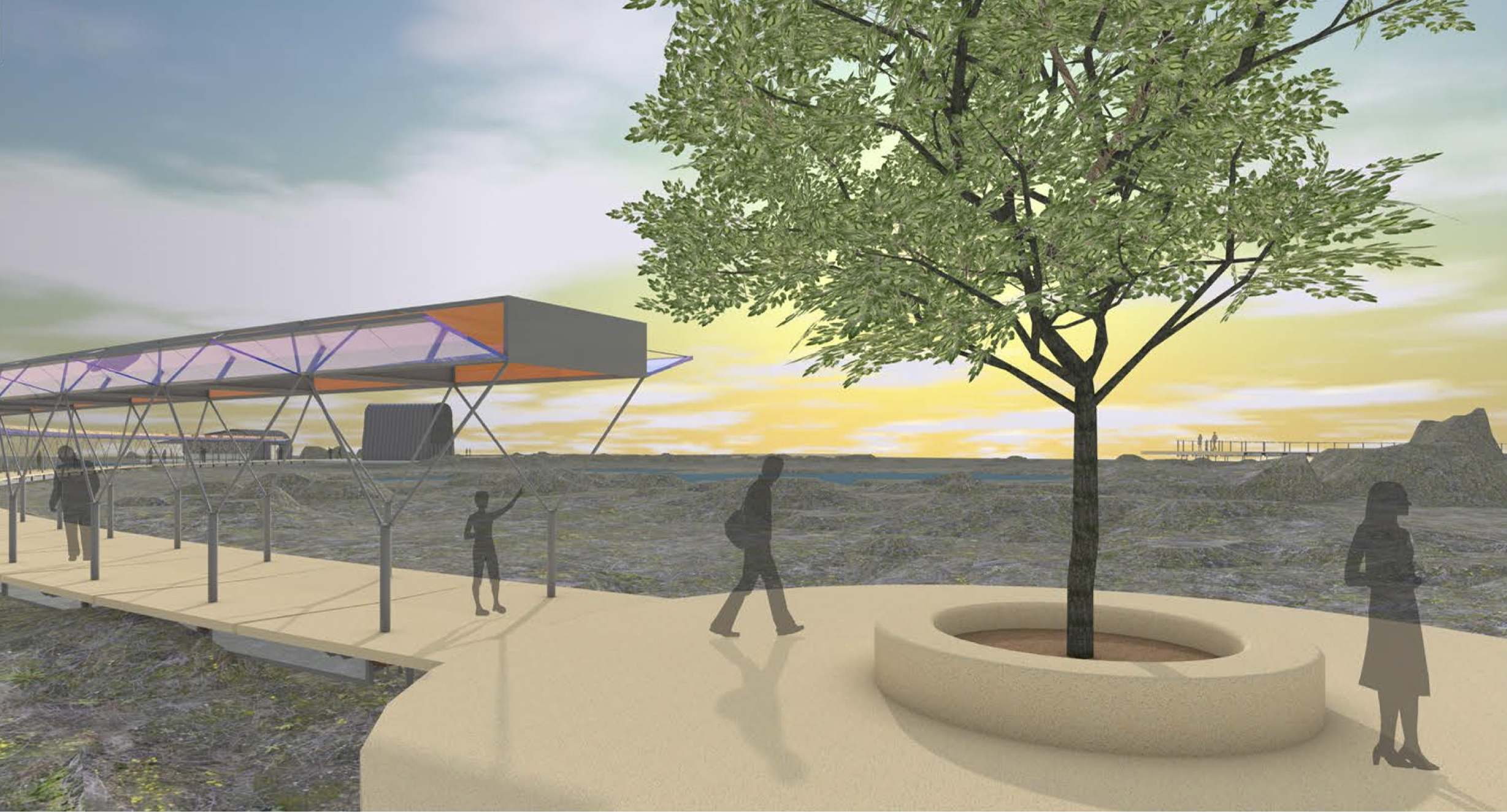
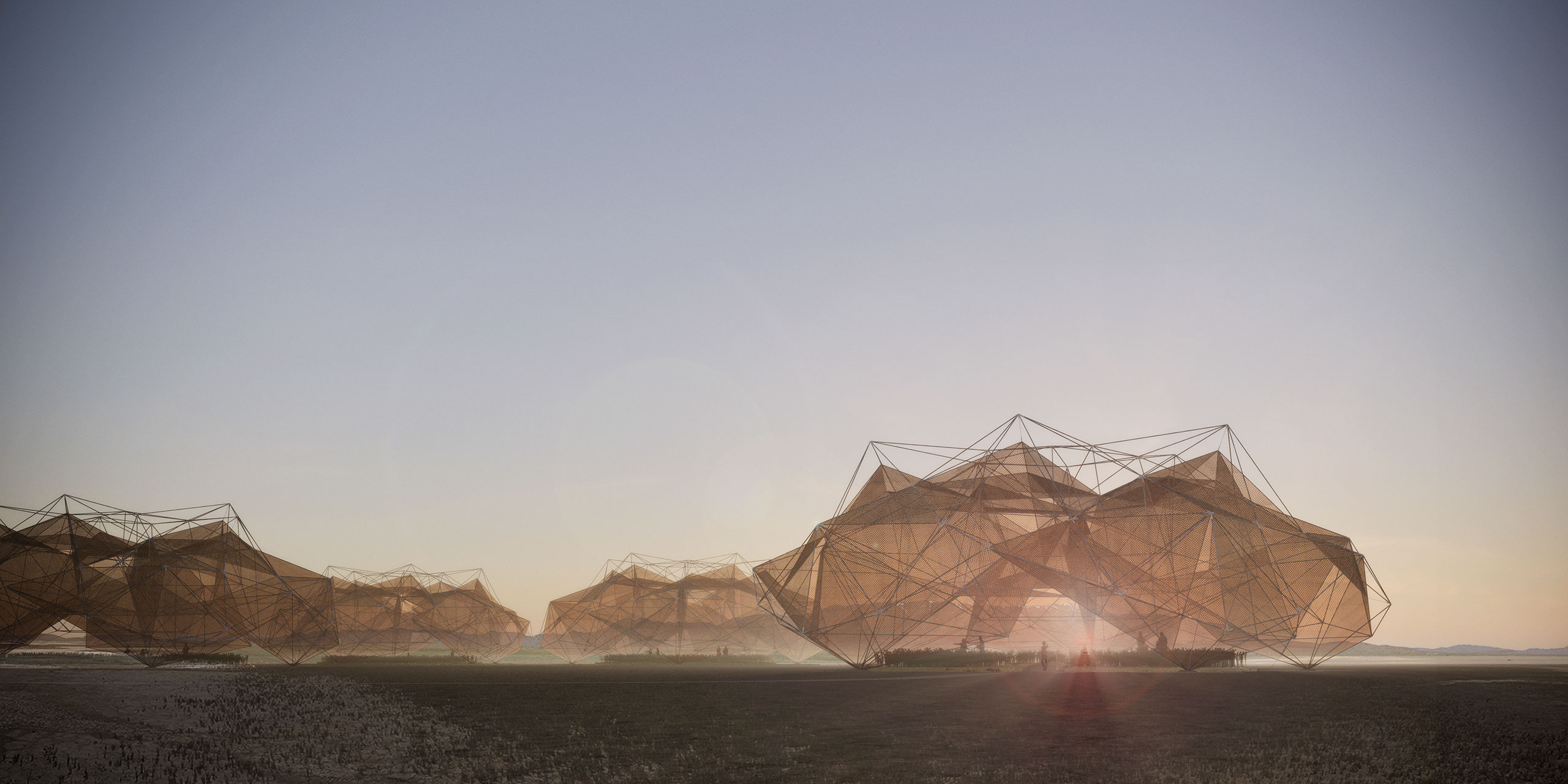
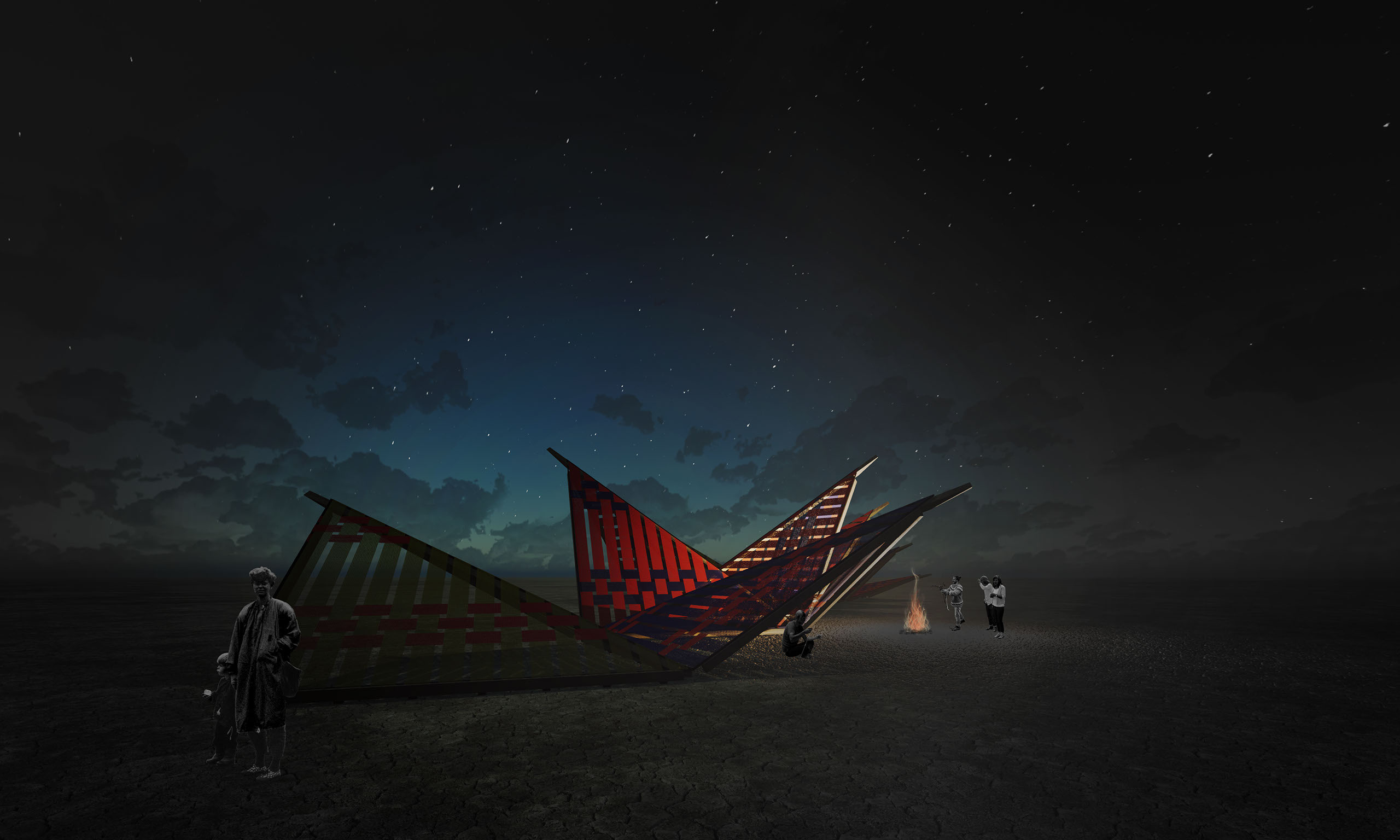


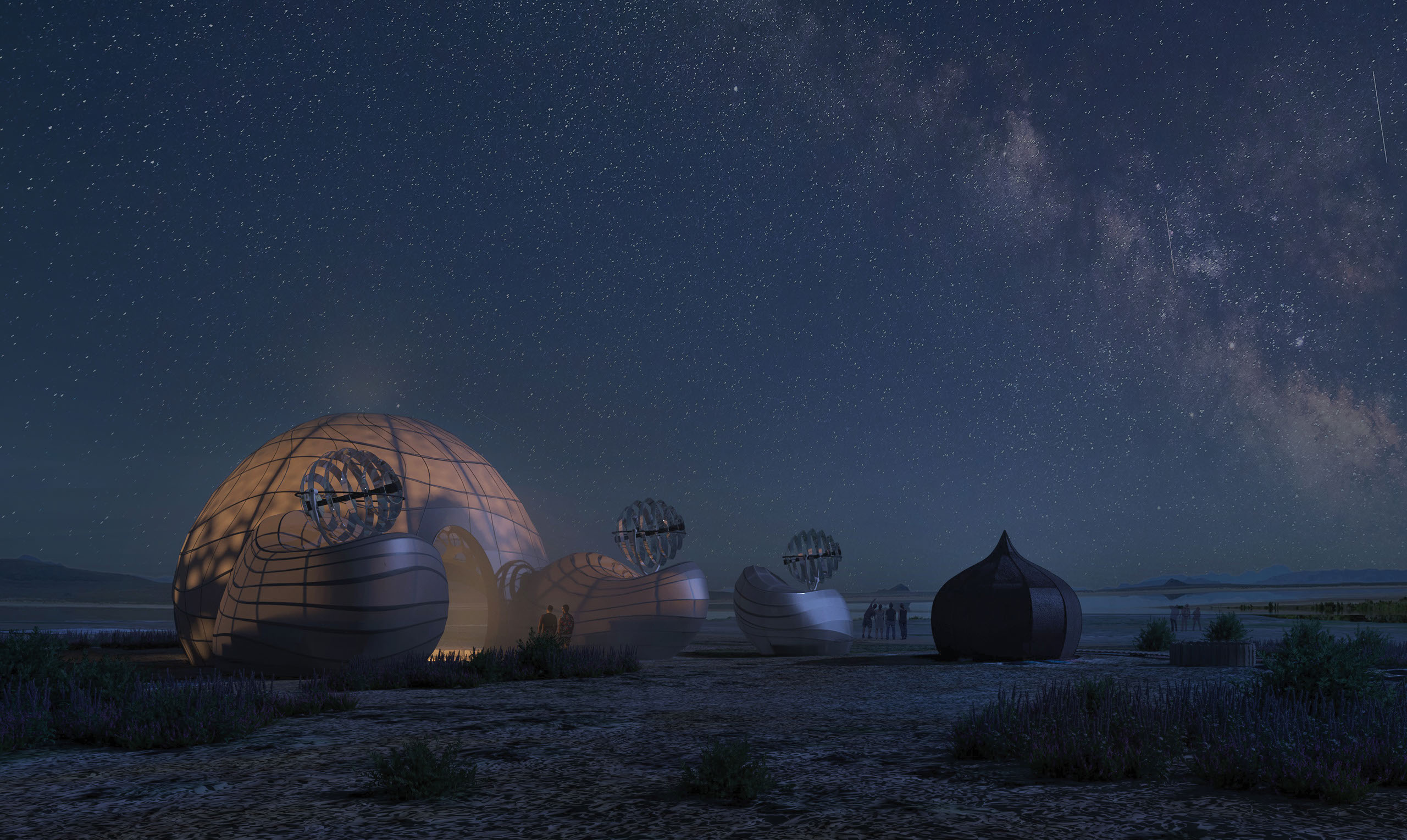

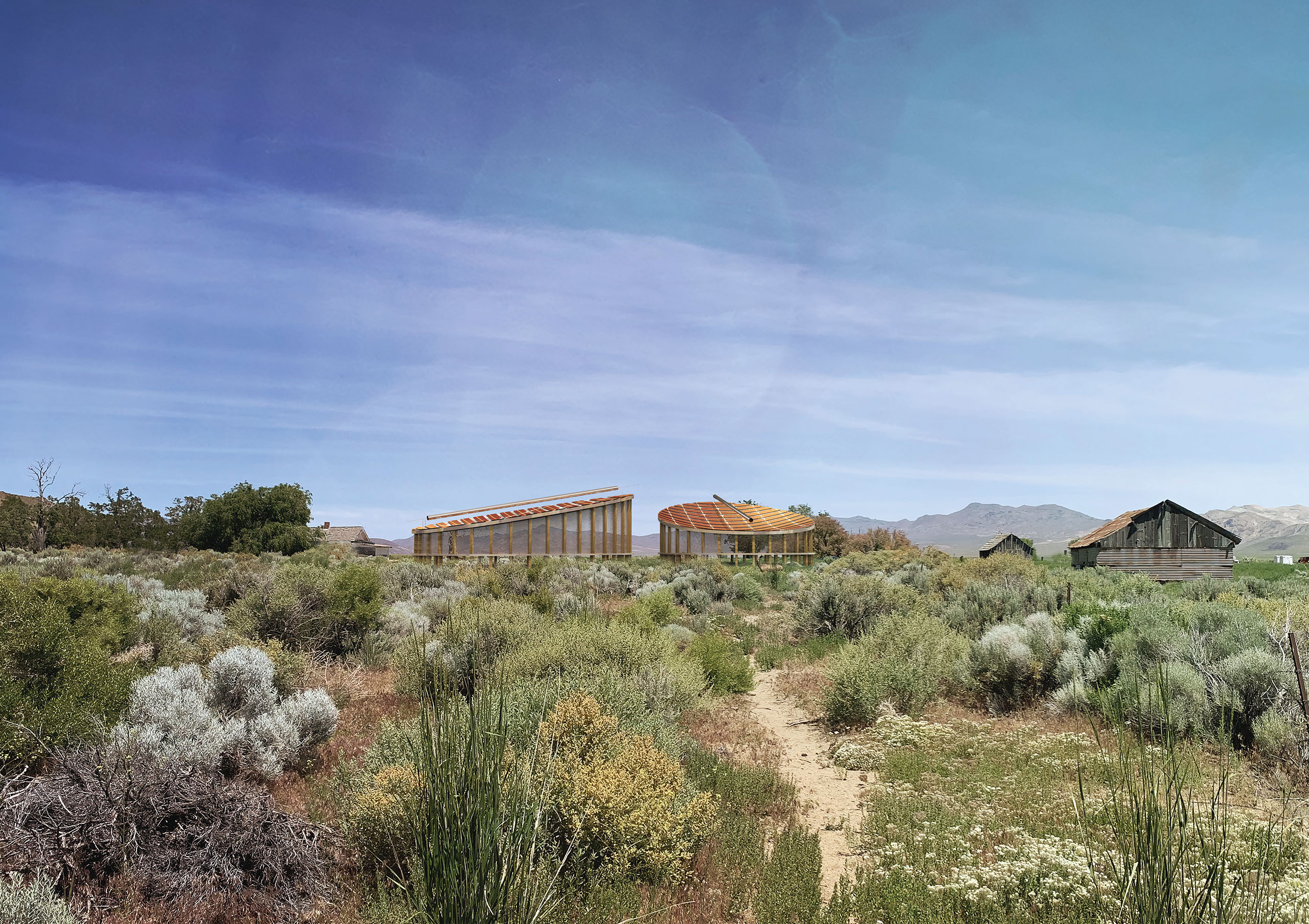
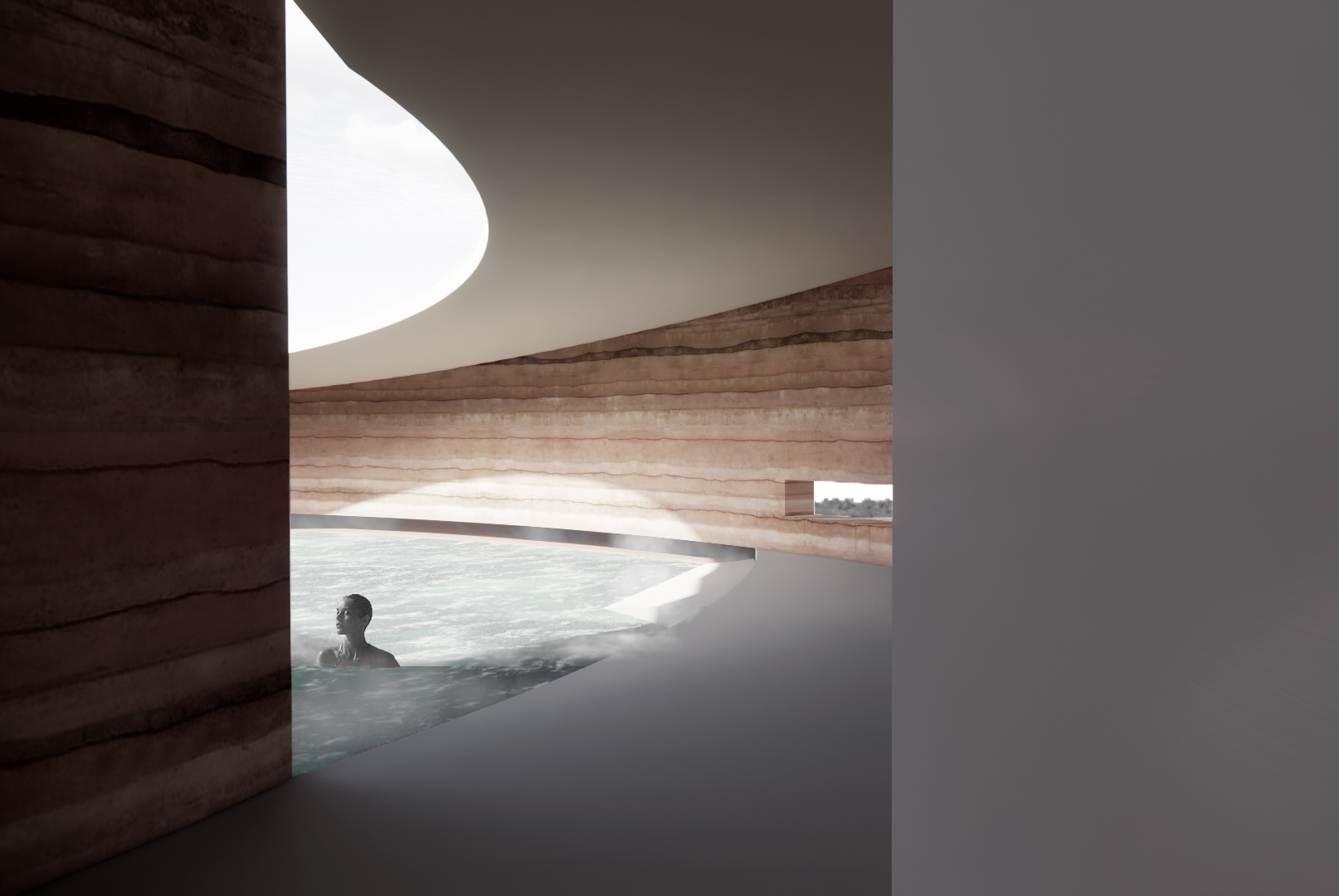
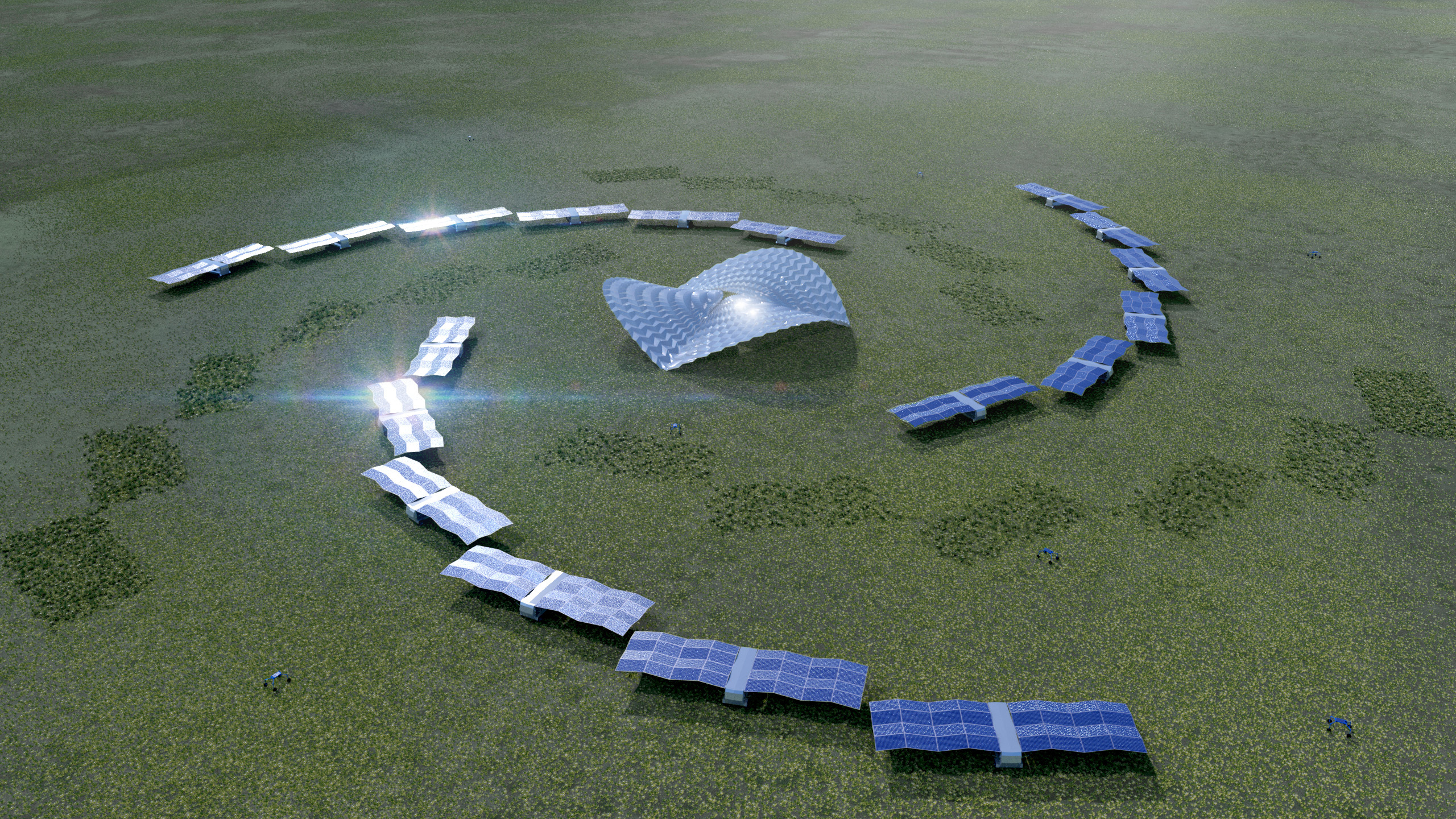

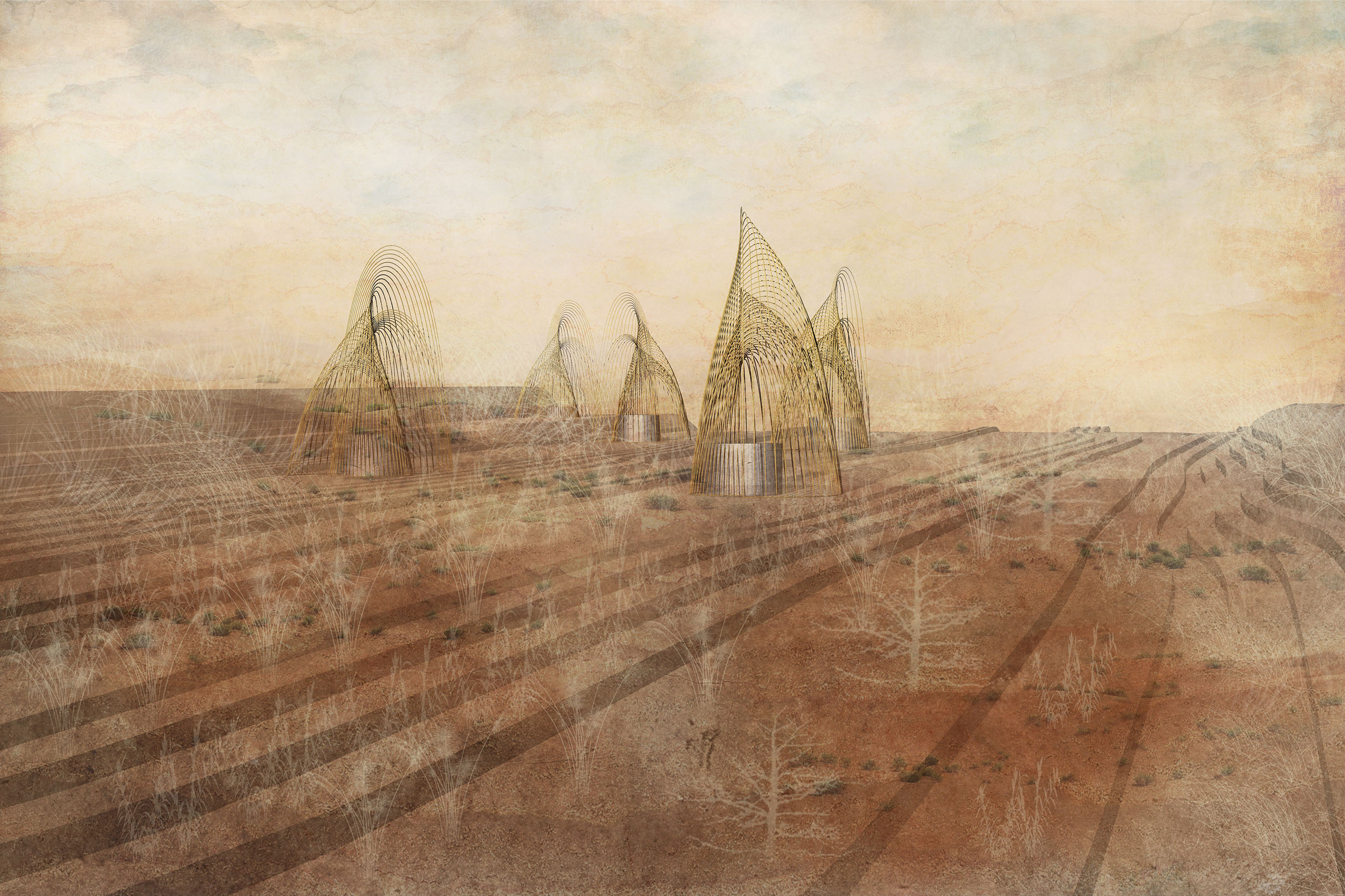

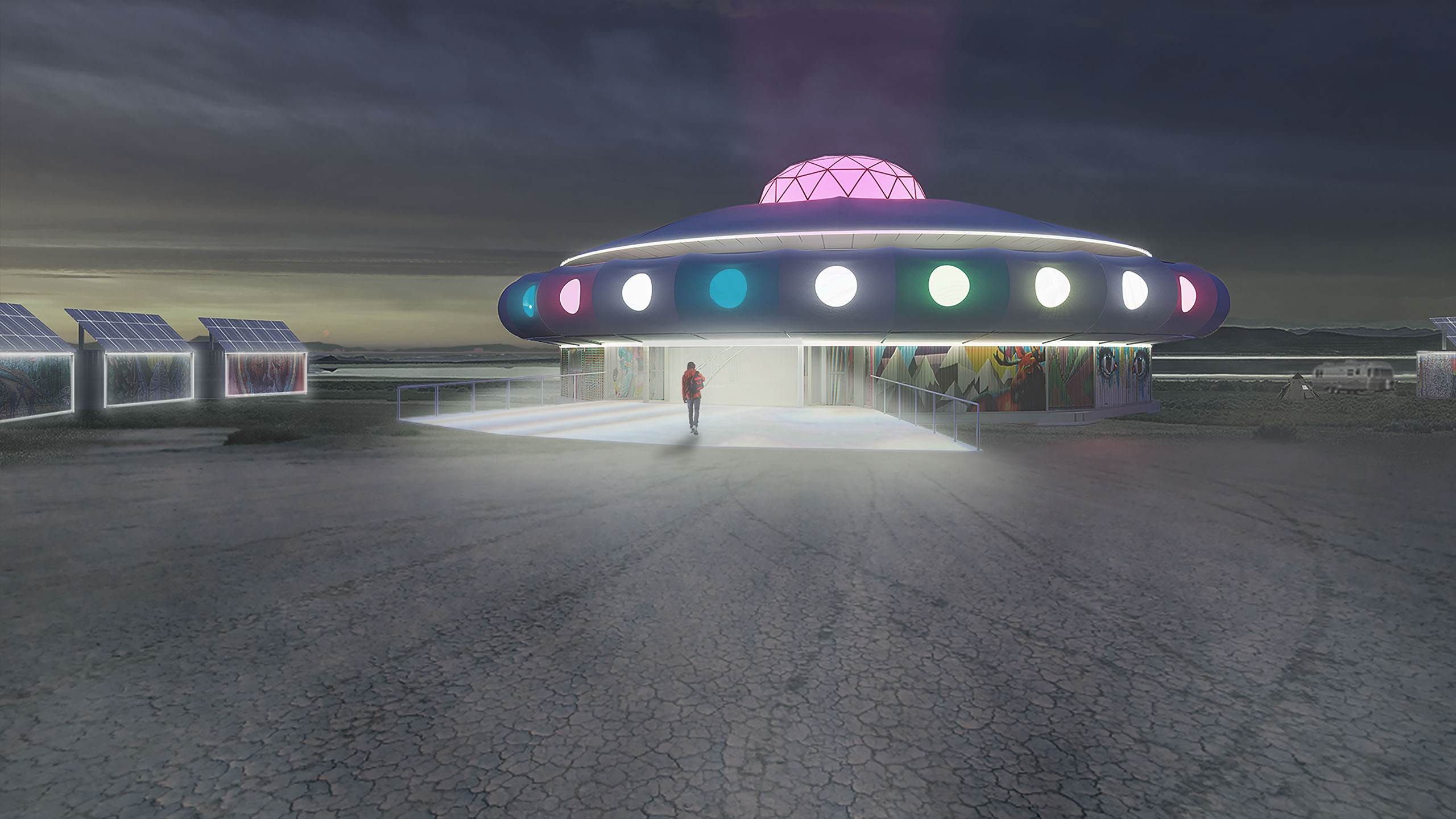
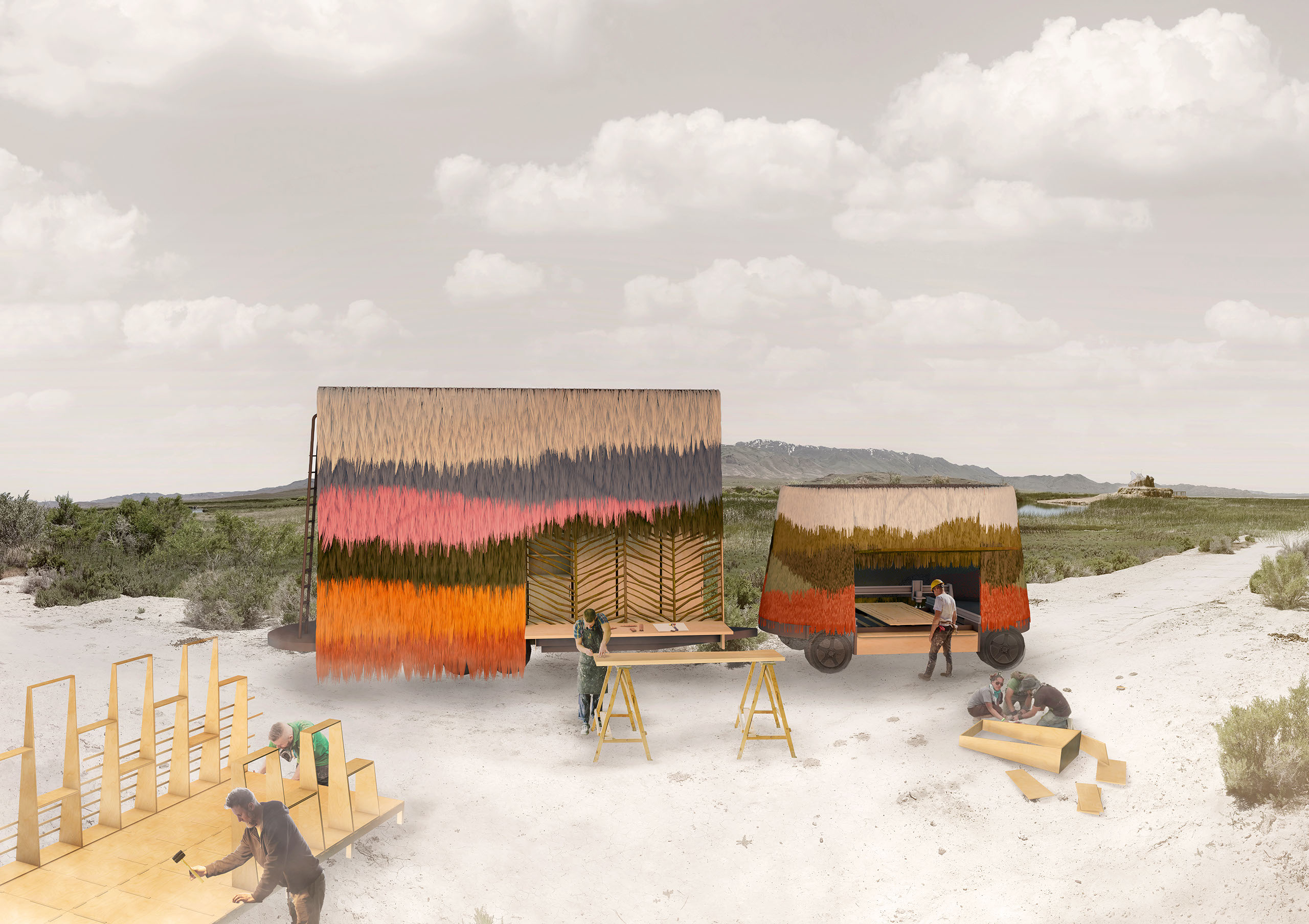























































Lodgers: Serendipity in the Fly Ranch Wilderness by Zhicheng Xu and Mengqi Moon He brings together composting toilets, reclaimed timber waste, traditional thatching methods using local materials, computational script-generated parametric design, and native species shelters to provide an environmental education venue, soil replenishment, sustainable waste management, and habitat enrichment for Fly Ranch.
The top-ranked proposal to the LAGI 2020 Fly Ranch Design Challenge.
Nexus by Antoniya Stoitsova, Nicolo Bencini, Ben Naudet, Avi Greene, Alex Ogata, and Tom Kendrew explores the design capabilities of Ferrock, a sustainable alternative to concrete that absorbs CO2 through the curing process of building components. A top ten proposal to the LAGI 2020 Fly Ranch Design Challenge.
SEED symbiotic coevolution by Samantha Katz, Woody Nitibhon, Henry O'Donnell, Lola Lafia, Eric Baczuk, John Hilmes, Max Schwitalla, and Colin O'Donnell incorporates solar, geothermal, passive cooling, composting, greenhouses, aquaponics, biodigesters, and greywater recycling.
A top ten proposal to the LAGI 2020 Fly Ranch Design Challenge.
The Source by Mateusz Góra and Agata Gryszkiewicz (Tamaga Studio) uses solar photovoltaic, battery energy storage, water cistern, rammed earth thermal mass, fruit trees, fruit walls, and compost to contribute 250 kg/year of food, 2.2 MWh/year of electricity, 9,000 liters/year of water, habitat enhancement, environmental education venue, and soil replenishment.
A top ten proposal to the LAGI 2020 Fly Ranch Design Challenge.
Coyote Mountain by Dusty Michael, Jane Maru, and Anna Meloyan brings together 5,256 MWh/year of low-temperature geothermal energy, luminescent solar concentrator photovoltaic, bladeless wind turbines, lithium-ion energy storage, and rammed earth construction to contribute 340 MWh of solar electricity per year, 120 MWh of wind electricity per year, and a large climate-controlled multipurpose space for creative activities.
A top ten proposal to the LAGI 2020 Fly Ranch Design Challenge.
Kiba paa'a: Mountains of Water by Javier Irigaray, Josien Visser, Mara Equisoain, Deyo Maeztu-Redin, and Silvia Larripa proposes a series of conservational, minimally intrusive, and reversible interventions to provide sustainable water collection based on the concept of islands of hydrologically enhanced biotic productivity inspired by traditional Indigenous technologies.
A top ten proposal to the LAGI 2020 Fly Ranch Design Challenge.
The Loop: How Pee and Poo Creates a Regeneration Service Station by Mathias Gullbrandson , Anna Johansson, Per Dahlgren, Julia Andersson, and Olle Bjerkås incorporates dehydration toilets, handwashing stations, straw bale construction, solar photovoltaic, natural water filtration, a hydroponic greenhouse, composting, and rainwater harvesting technology to contribute fertilizer, fruit trees, vegetables, greens, and 1.5 million liters/year of irrigation water.
A top ten proposal to the LAGI 2020 Fly Ranch Design Challenge.
Solar Mountain by Nuru Karim and Anuj Modi uses solar photovoltaic, and recycled materials to contribute 300 MWh of electricity per year and interactive spaces for play and exercise.
A top ten proposal to the LAGI 2020 Fly Ranch Design Challenge.
Veil: An Armature Containing Void by Jamieson Pye incorporates walipini greenhouses and gravity fed water filtration within an innovative construction using local materials to provide food and to create spaces of cohabitation while generating zero waste.
A top ten proposal to the LAGI 2020 Fly Ranch Design Challenge.
Ripple by Matthew Lagomarsino, William Jacob Mast, Pierre-Yves Bertholet, Xiaojin Ren, Scherwyn Udwadia, Bas Kools, Israel Orellana, and Melika Tabrizi integrates electrochromic glass, a bioceramic dome (Geoship SPC), seed bank, solar photovoltaic, cisterns, drip irrigation, composting toilets, and native restoration plants to provide shelter, food, medicinal herbs and teas, habitat enhancement, water harvesting, 36 MWh/year of electricity, and 40,000 liters/year of harvested water. A top ten proposal to the LAGI 2020 Fly Ranch Design Challenge.
The COOPx: Mobile Hen Houses for Fly Ranch by J. Matthew Thomas is a series of modular solar-powered climate controlled hen houses that provide organic and free-range eggs while fertilizing the Fly Ranch soil, providing a sustainable use for food waste, and engaging the community in a sustainable local economy. Shortlisted proposal to the LAGI 2020 Fly Ranch Design Challenge.
A Pinch of Earth by Nicholas Bartlett uses passive and active solar design, composting toilet, water harvesting, living roof, and maglev technology that optimally orients the building in relation to the sun to provide sustainable shelter for Fly Ranch. Shortlisted proposal to the LAGI 2020 Fly Ranch Design Challenge.
Evolving Community in Oasis: E.C.O. by Tatiana Prevezentseva, Pelikh Anna Vitalievna, Shkarupa Anastasia Aleksandrovna, Ryseva Tatiana Sergeevna, Murashko Tatiana Andreevna, and Starostin Nikita Dmitrievich uses low temperature pyrolysis to reduce waste streams while providing power to a series of multipurpose spaces with interactive experiences and fertilizer to agricultural fields. Shortlisted proposal to the LAGI 2020 Fly Ranch Design Challenge.
Gather. Rest. Create. Fly Ranch. by Michael Colton and Mathieu Lapotre incorporates passive thermal design with earth-bermed SuperAdobe earthbag construction, strawbale insulation, ETFE glazing, geothermal hot water, stack effect and evaporative cooling to provide a net zero multipurpose shelter. Shortlisted proposal to the LAGI 2020 Fly Ranch Design Challenge.
The Origin Pod: From Water There is Life by Clara Nagy McBane, Jason Hooper, Richard Haynie, Amy Erickson, and Neil Grimmer uses atmospheric water generation technology from Source powered by solar photovoltaic to contribute potable water for Fly Ranch. Shortlisted proposal to the LAGI 2020 Fly Ranch Design Challenge.
Sage Spark by Frances Lai, Hanif Wicaksono, and Maximilian Mueller incorporates permaculture techniques, rammed earth construction, polymer stabilized earth foundations, and biomass brick-making press that uses local materials to produce carbon negative fuel briquettes made through cooperative ritual to illuminate the streets of Black Rock City, make natural soap, and support activities at Fly Ranch. Shortlisted proposal to the LAGI 2020 Fly Ranch Design Challenge.
WAGI: The Laws of Thermo Dining by Meredith Busch and Andrew Tsuei incorporates geothermal heat, aquaponic gardening, and wetland water filtration to contribute organic produce, farmed trout, a sauna, and bathhouse. Shortlisted proposal to the LAGI 2020 Fly Ranch Design Challenge.
Breathing Room by Lekha Washington uses a hexagonal modular dome structure, solar photovoltaic, vertical gardening, drip irrigation, ultra-wide band radio technology, and sonar sensors to create interactive living shelters. Shortlisted proposal to the LAGI 2020 Fly Ranch Design Challenge.
CACTi by Jaeyual Lee, Haemee Han, Daeho Lee, and Beomki Lee incorporates algae photobioreactors and photovoltaic modules to contribute 137 liters of biofuel per tower per year and individual shelter while sequestering carbon from the atmosphere. Shortlisted proposal to the LAGI 2020 Fly Ranch Design Challenge.
FlyHive by Ellie Sass, Carl Fosholt, Alan Lum, Amy Shu Chang, Daniel Muccino, Ali Lahijanian, and Selinda Martinez is a modular and solar powered system using recycled plastic and reclaimed wood with mycelium insulation to provide temporary dwelling spaces. Shortlisted proposal to the LAGI 2020 Fly Ranch Design Challenge.
Sources of Puha, Modular Earth Domes, Learning Man by Adrien Thivolle incorporates geothermal hot water, binary Rankine cycle low-temperature geothermal electricity, and SuperAdobe earthen construction to contribute thermal baths, greenhouses, and multipurpose event spaces. Shortlisted proposal to the LAGI 2020 Fly Ranch Design Challenge.
The Collectors by Andre Gomez and Eric Ramirez uses post and beam charred timber, solar photovoltaic, battery storage, rainwater harvesting, and locally sourced sedge grass thatched roofing to provide up to 12.7 MWh/year/unit, and net-positive shelter. Shortlisted proposal to the LAGI 2020 Fly Ranch Design Challenge.
The Perfect Outhouse by John Stewart, Todd Downs, Greg Hamm, Thomas Dangerfield, and Joshua Gedney uses locally sourced organic materials to create a pulp that is dried and cast to create temporal outhouse enclosures. Shortlisted proposal to the LAGI 2020 Fly Ranch Design Challenge.
Agrivoltaic Architecture by Jenny Sabin, Mariana Bertoni, Alexander Htet Kyaw, Begum Birol, Jack Otto, Angel Langumas, and John Hilla utilizes dichroic films, thin-film photovoltaic, battery storage, and 3D printing with PETG filament created from recycled bottles to generate 1.2 MWh/year of electricity for each acre of agricultural with increases in productivity of up to 70% over conventional fields. Shortlisted proposal to the LAGI 2020 Fly Ranch Design Challenge.
Aqua Planterra by Felix Cheong, Haley Zhou, and Rachel Cohen-Murison uses locally sourced clay vessels and coiling pottery techniques to contribute 70,000 liters of potable water/year/vessel, 684 cups of edible plants and herbs per year/vessel, educational programming for the local community, sustainable goods for a circular economy, and enhanced habitat for local species. Shortlisted proposal to the LAGI 2020 Fly Ranch Design Challenge.
AXIS-ponics by Chenyu Zhang incorporates large-scale aquaponic systems and geothermal hot water to contribute significant quantities of kale, pepper, and spinach for consumption on site and exchange with the community. Shortlisted proposal to the LAGI 2020 Fly Ranch Design Challenge.
BioSpike by Thomas Lantz uses bioluminescent algae in photobioreactors to generate nearly 300,000 liters of biofuel per year while sequestering carbon from the atmosphere. Shortlisted proposal to the LAGI 2020 Fly Ranch Design Challenge.
Bridging Binaries by Rohin Sher, Ms. Urooj Iqbal, and Ms. Pradhi Pathak uses compressed earth blocks, catenary vaults, flexible thin-film photovoltaic, and piezoelectric pavers to generate 320 MWh/year and multipurpose indoor-outdoor spaces. Shortlisted proposal to the LAGI 2020 Fly Ranch Design Challenge.
Burning Again by Yuxiang Sun, Fangning Wang, Mengfan Chen, and Yu Cao incorporates solar photovoltaic and regenerative construction techniques using reclaimed ash and recycled waste materials to contribute sustainable composting toilets. Shortlisted proposal to the LAGI 2020 Fly Ranch Design Challenge.
Desert Bloom: Planting a Paradigm Shift by George Beinetti, Ari Raeburn, Hannah Noll, Jeancarlo Barrientos, Shuhua Li, Meaghan Keefe, and Sean Satchwell incorporates a solar photovoltaic microgrid, battery storage, luminescent solar concentrators to contribute a sustainable event space and temporary shelters. Shortlisted proposal to the LAGI 2020 Fly Ranch Design Challenge.
Dig/Dug City by Lucas Hitch, Brendan Sullivan Shea, Noémie Despland-Lichtert, Kristina Fisher, and Martin Francis Hitch uses earth casting construction with local and low-carbon materials, flexible thin-film photovoltaic solar, passive solar thermal, to create organic spaces of sustainable habitation. Shortlisted proposal to the LAGI 2020 Fly Ranch Design Challenge.
DragonFly Flats at Fly Ranch by Lisa Wipplinger, Teresa McNulty, and Janus Welton incorporates sustainable building materials, biomimetic design, water harvesting, vertical axis wind turbines, and solar photovoltaic to create iridescent temporary dwelling units for Fly Ranch. Shortlisted proposal to the LAGI 2020 Fly Ranch Design Challenge.
The Elements by Sima Shahverdi, Anet Kashoa, Nima Torabkhani, and Kamilla Csegzi uses rammed earth construction with local materials, rainwater harvesting, geothermal hot water, evaporative cooling, and ancient wind tower technology to passively heat and cool modular shelters. Shortlisted proposal to the LAGI 2020 Fly Ranch Design Challenge.
Fly Haven by Nathan Bonneville, Valerie Beauregard, Grace Cheong, Marco Chimienti, and Pierre-Charles Gauthier uses reinforced and cementitious rammed earth construction using local material to create shelter and protected gardens, apiaries, and fish ponds. Shortlisted proposal to the LAGI 2020 Fly Ranch Design Challenge.
Flyline by Danielle Siembieda, Victor Etienne, Eckhart Beatty, Raj Banjeer, John Sarter, and John Randolph incorporates solar photovoltaic, battery storage, composting toilets, informed by geomantic principles relating the stars and earth through the golden mean to contribute shelter, showers, and a shaded interactive mindfulness journey along a boardwalk through the Fly Ranch landscape. Shortlisted proposal to the LAGI 2020 Fly Ranch Design Challenge.
Geocatcher by Ricardo Solar Lezama, Jeremy Nguyen, and Ricardo Solar integrates photovoltaic fabric, atmospheric water harvesting, and sustainable agriculture into a unique structure and geometry that contributes shaded shelter, 25 MWh of electricity, 50,000 liters of water, and 400 kg crop yield per year. Shortlisted proposal to the LAGI 2020 Fly Ranch Design Challenge.
HUTSA’WA TABA by Remy Jansen (The Lone Architects) incorporates solar and mechanical energy harvesting textiles developed in collaboration between Georgia Institute of Technology and Chongqing University, and bio-based batteries by SuWoTec to generate and store clean electricity and create shaded workshop and event spaces. Shortlisted proposal to the LAGI 2020 Fly Ranch Design Challenge.
Hyphae by Háta Enochová, Petr Stojaník, and Marek Kratochvíl uses mycelium and wicker construction to contribute multipurpose event spaces and temporary dwellings. Shortlisted proposal to the LAGI 2020 Fly Ranch Design Challenge.
Jewels in the Desert by Cal Tompkins incorporates mycelium clad inhabitable organic structures that act as a permanent dam to stabilize the existing reservoir along with aquaponic greenhouses that contribute 90,000 kilograms of fresh food per year. Shortlisted proposal to the LAGI 2020 Fly Ranch Design Challenge.
KADMON by Boris Ryabov (Steamology Institute), Liya Ivanova, Kirill Ivanov, Sergey Ivanov, Olga Kritova, Laurent Rains, llyaz Khairov (Archmeta Studio), and Michael Bogomolny (Archmeta Studio) incorporates concentrated solar thermal with dual-axis tracking and Fresnel reflectors, hydronic floor heating, and Airtex membrane construction to provide a communal bakery, multipurpose spaces, steam sauna, and community gardens. Shortlisted proposal to the LAGI 2020 Fly Ranch Design Challenge.
Made from Dust: A Fly Ranch Discovery Trail by Luis Philippsen utilizes wood ash bricks that naturally absorb carbon from the atmosphere over their life cycle using waste material from the annual Burning Man event to create enclosed incubator gardens and natural fertilizer. Shortlisted proposal to the LAGI 2020 Fly Ranch Design Challenge.
META.ZERO.BOLISM by Gaby San Roman integrates greywater and blackwater recycling technologies including aerobic granular sludge, microfiltration, and reverse osmosis, with building integrated concentrated solar power thermal to provide shelter, freshwater for irrigation, and a sustainable waste stream for the annual Burning Man event. Shortlisted proposal to the LAGI 2020 Fly Ranch Design Challenge.
o-phosis by Karen Correa, Erika del Carmen, Trejo Aguirre, and Sofía Itzel Ávila Flores incorporates rammed earth construction, atmospheric water harvesting, porcelain air purification, passive bioclimatic thermal design, and luminescent solar concentrator photovoltaics to provide universally accessible multipurpose spaces, wellness, and support a circular economy at Fly Ranch. Shortlisted proposal to the LAGI 2020 Fly Ranch Design Challenge.
Regenerating Fly Ranch by PALMA Team, Jo Palma, Iana Kolev, Daniel Confroy, Han Shen, Zach Coffin, Alex Au, Dr. Ryan Wartena uses solar powered autonomous rewilding vehicles to reduce invasive species, plant native vegetation, fertilize the soil, and create irrigation systems across Fly Ranch. Shortlisted proposal to the LAGI 2020 Fly Ranch Design Challenge.
Rings of Regeneration: Opening Spaces for Sustainable Creative Practices at Fly Ranch by Emily Nicolos and Anna Kissell includes permaculture rammed earth construction, living roofs, solar photovoltaic, and passive solar to contribute spaces for upcycling workshops, gardens, and short stay dwelling. Shortlisted proposal to the LAGI 2020 Fly Ranch Design Challenge.
Sagebrush [Re]generation by Waiyee Chou uses low-impact technologies such as water harvesting textiles and local vegetation, to provide phytoremediation of soil and water and support sustainable agricultural activities at Fly Ranch. Shortlisted proposal to the LAGI 2020 Fly Ranch Design Challenge.
SkyWater by P.K. VanderBeke, Migel Santos, Alexandra Flora-Ferreira, and Lorenz Mager uses atmospheric water generation technology and solar photovoltaic to create drinking water stations and wayfinding markers for Fly Ranch. Shortlisted proposal to the LAGI 2020 Fly Ranch Design Challenge.
Starship by Alexander Dzurec, Ivan Spratte, and Tim Schwartz incorporates repurposed shipping containers, solar photovoltaic, water harvesting, greywater and blackwater treatment, greenhouses, composting to create a closed loop multipurpose event space and flexible living modules. Shortlisted proposal to the LAGI 2020 Fly Ranch Design Challenge.
The Hatchery by Nicholas DeBruyne and Andrew Persoff Oroz uses a modular unit that contains a CNC machine and wood workshop clad with locally sourced thatching and with solar modules and rainwater harvesting for a self-contained mobile digital fabrication maker space that blends with the landscape. Shortlisted proposal to the LAGI 2020 Fly Ranch Design Challenge.
View/Sheds by Llewelynn Fletcher, Charles O'Geen, and Catherine Harris uses an innovative poured earth construction technique with locally sourced clay and geotextile bags, and incorporates mPower DragonScalesTM solar technology, battery storage, geothermal heat, repurposed wood and windows, and passive thermal design to provide a network of shelters and gathering spaces. Shortlisted proposal to the LAGI 2020 Fly Ranch Design Challenge.
We Are Guests On This Land by Jose Herrasti, Shilpa Mevada, Monica Lamela, and Fernanda Oppermann uses earthen construction, water harvesting, floating farming islands (chinampas) to contribute organic produce and a variety of engaging spaces. Shortlisted proposal to the LAGI 2020 Fly Ranch Design Challenge.
Weeping Desert Lab by Félix de Rosen, Rourke, Luke Wilson, Matt Turlock, and Eric Futerfas uses geothermal heat, solar still, thermal mass, ETFE film, and bamboo construction to create a passive geothermal greenhouse, 40,000 liters of irrigation water per year, and 1,500 kilograms of organic produce. Shortlisted proposal to the LAGI 2020 Fly Ranch Design Challenge.
>
<
LAGI 2020
Fly Ranch
The LAGI 2020 Fly Ranch Design Brief invited designs in one or more of the following systems as works of functional and regenerative art:
POWER
Solar, Wind, Bio, Geothermal, Storage
With 250+ sunny days a year, regular winds that can exceed 40mph and dozens of hot springs, Fly Ranch has vast potential for developing creative solutions for renewable power from solar, geothermal, wind, and more.
WATER
Hot Springs, Filtration, Evaporation, Ice
With dozens of hot and cold springs, hundreds of pools, and half a dozen artesian wells, water is the lifeblood of Fly Ranch. We invite creative solutions for spring water filtration, sustainably generated ice and the purification and reuse of greywater. To prevent erosion, scalable designs for use of the hot springs are needed.
SHELTER
Housing, Event Spaces, Sustainable Architecture
This expansive and harsh desert climate provides opportunities to combine modern architectural and technological innovation with traditional off-grid building techniques like natural materials and passive heating/cooling for housing, camping, and gathering spaces to fit a wide range of needs from small overnight shelters to large-scale next generation fabrication centers for artists and makers.
FOOD
Permaculture, Aquaponics, Gardens, Grazing
Fly Ranch has several hundred acres of previous ranch land that can be reinvigorated to create sustainable agriculture systems for on-site events, local communities, and beyond. The site can become a laboratory for pioneering methods of desert permaculture systems and large-scale indoor desert hydroponics and aquaponics.
REGENERATION
Composting, Recycling, Waste Biogas, Incineration
As part of the transition from temporary events to a year-round site, we have new opportunities to explore sustainable methods for composting and recycling. We can also explore new methods for rewilding pastureland, restoring landfills, and generating energy through safe incineration.
LAGI 2020
site typology: desert systems
LAGI 2020 Partner
Burning Man Project
Each August, the annual Burning Man event transforms a desolate corner of northern Nevada into a thriving temporary metropolis fueled by creativity, experimentation and awe. In 2016, the organization behind this city acquired Fly Ranch, a 3,800 acre property just north of the event site. This property is home to dozens of hot and cold springs, three geysers, acres of wetlands, dozens of animal species, and more than 100 identified types of plants. The Fly Ranch project is an opportunity to create a year-round rural incubator for Burning Man culture and a catalyst for creative culture in the world.
Please visit the project website:
lagi2020flyranch.org
